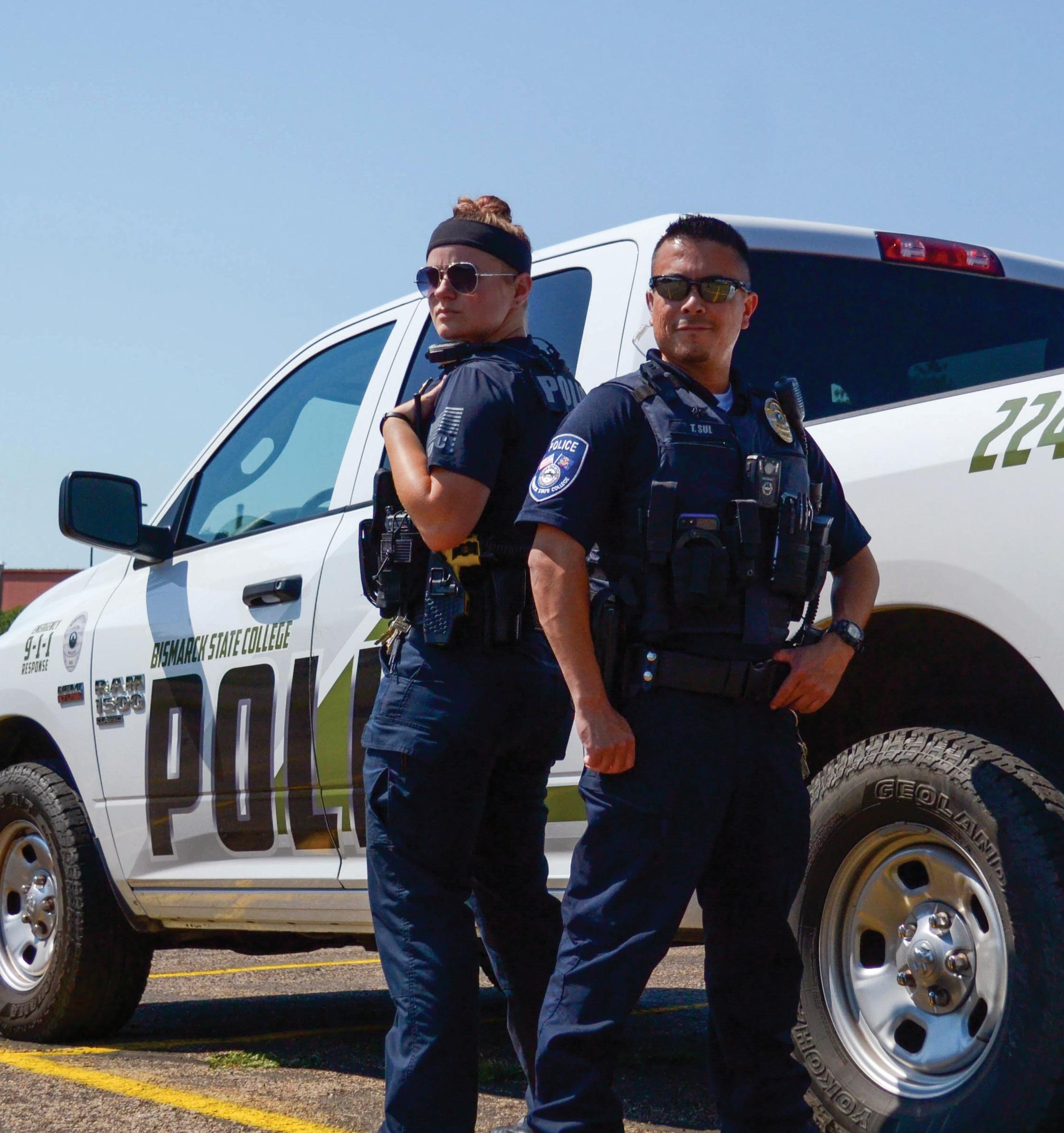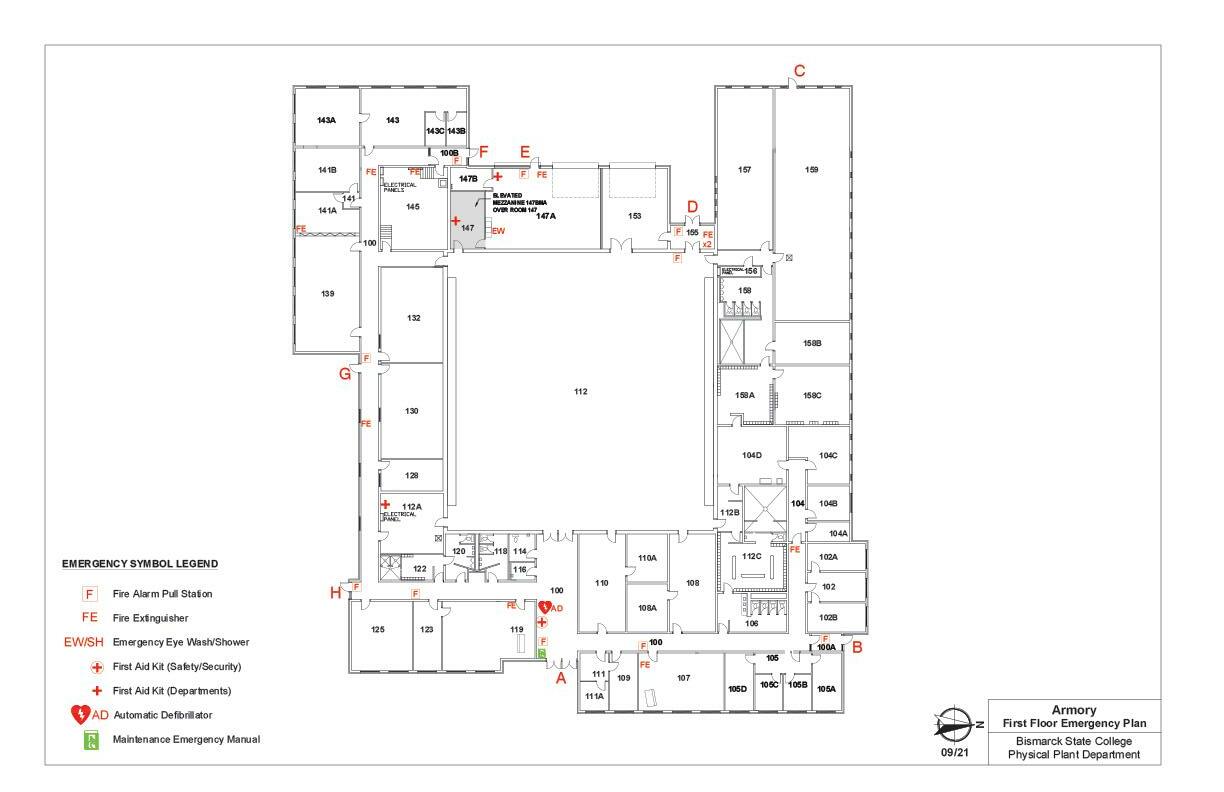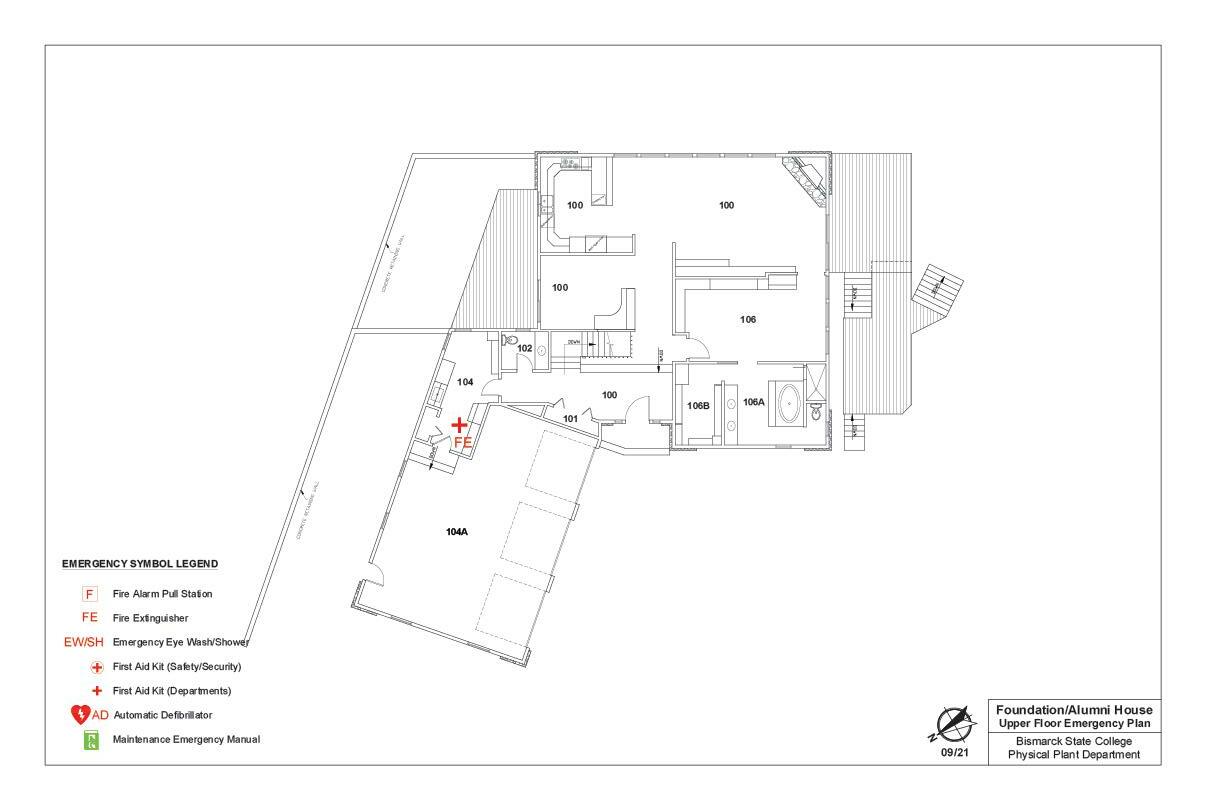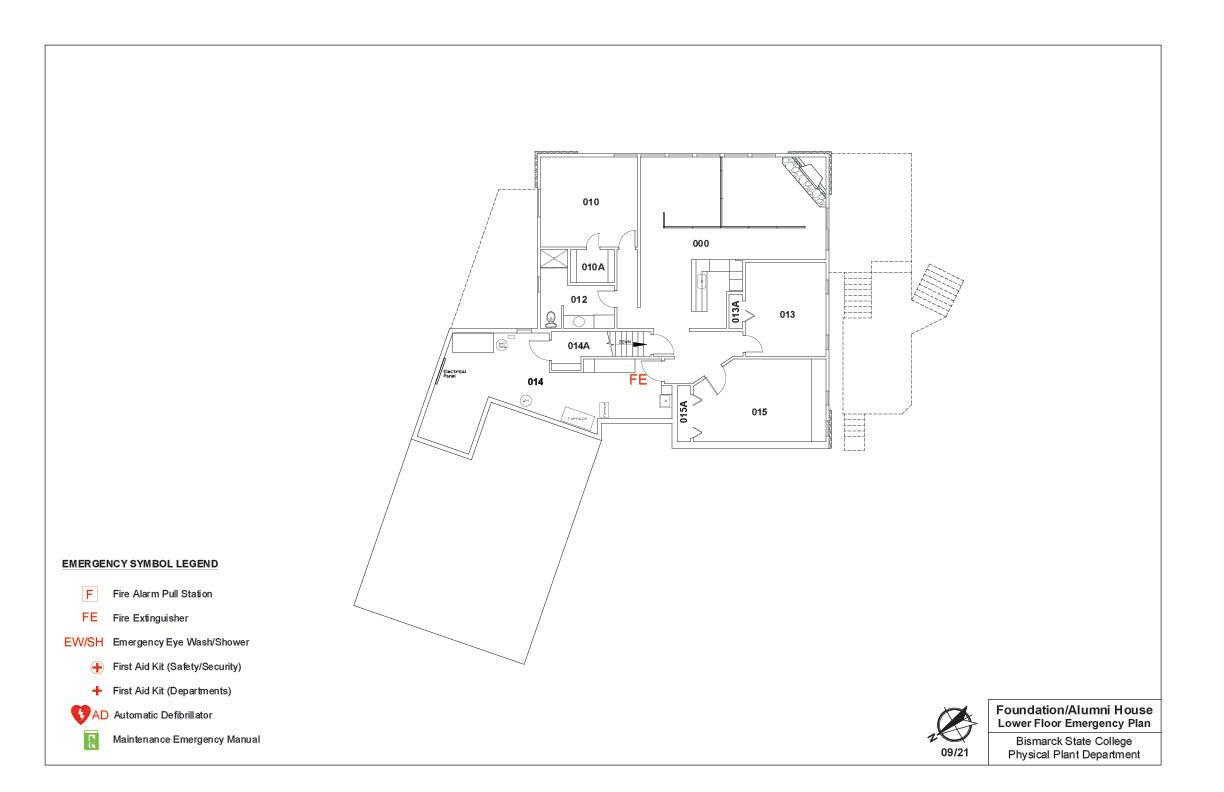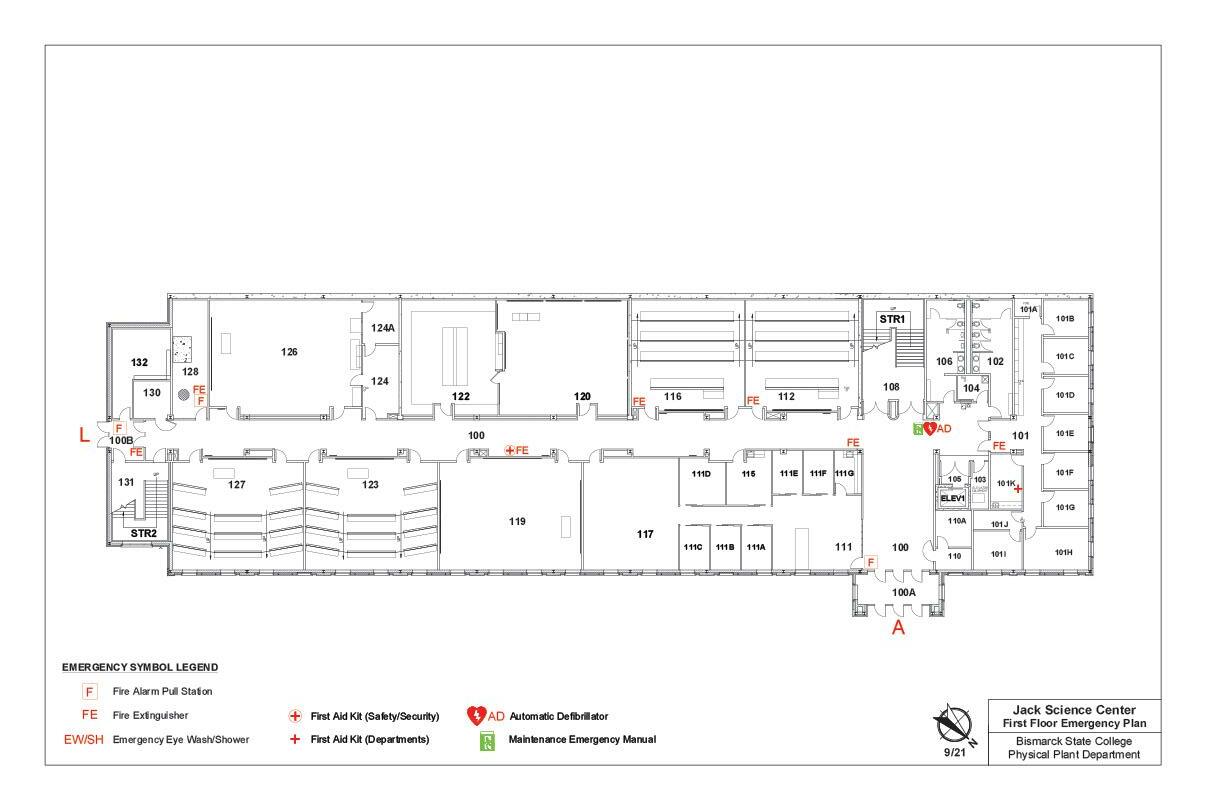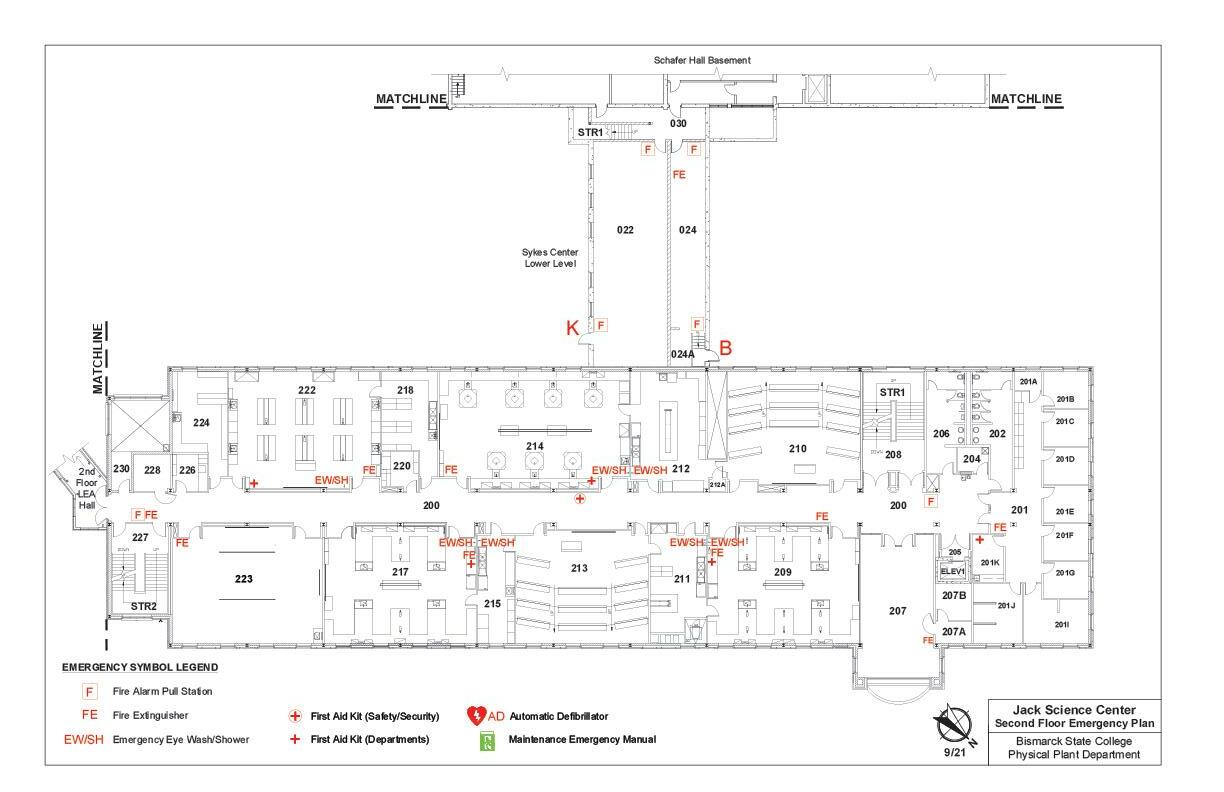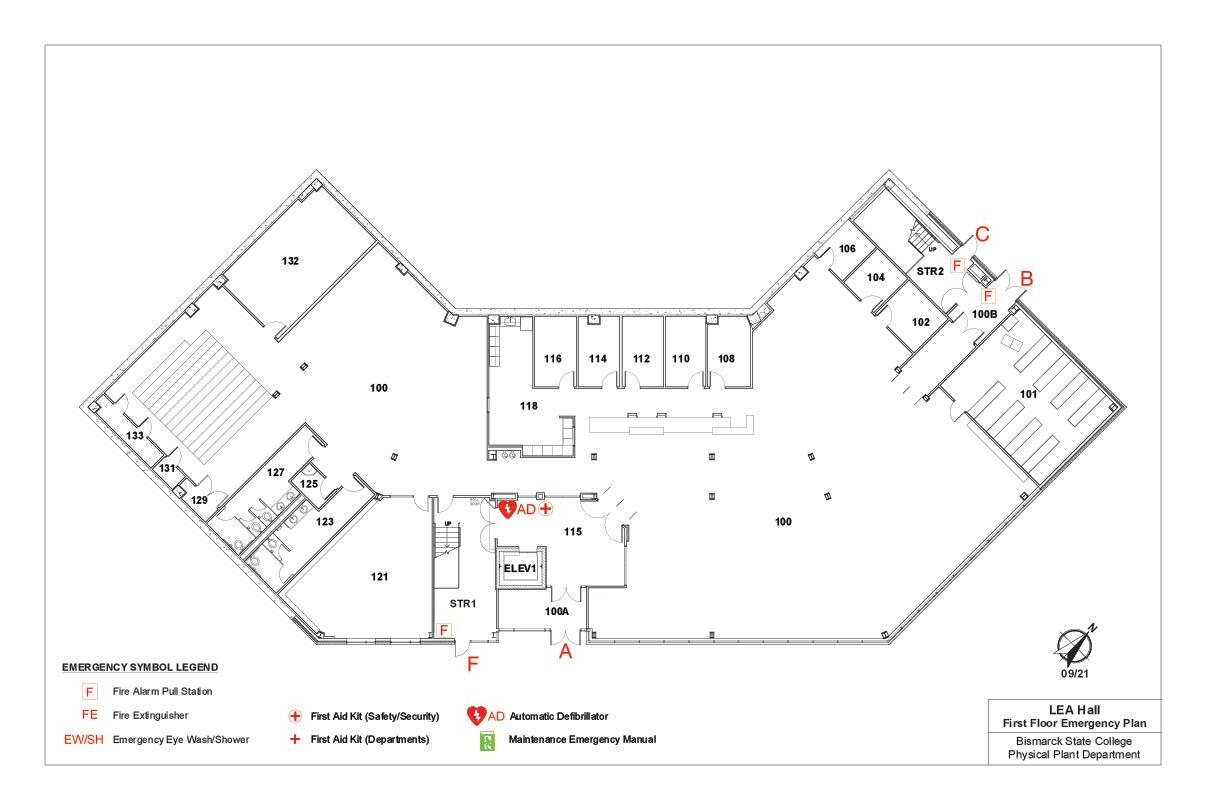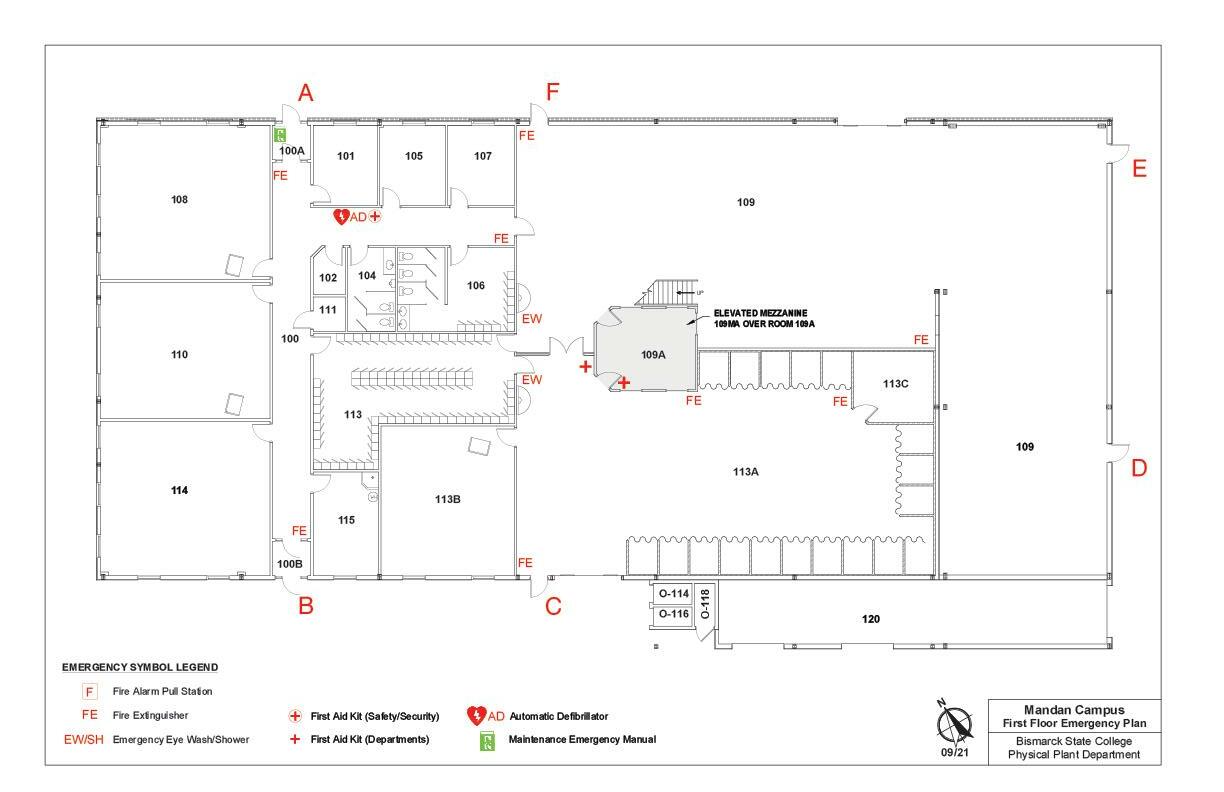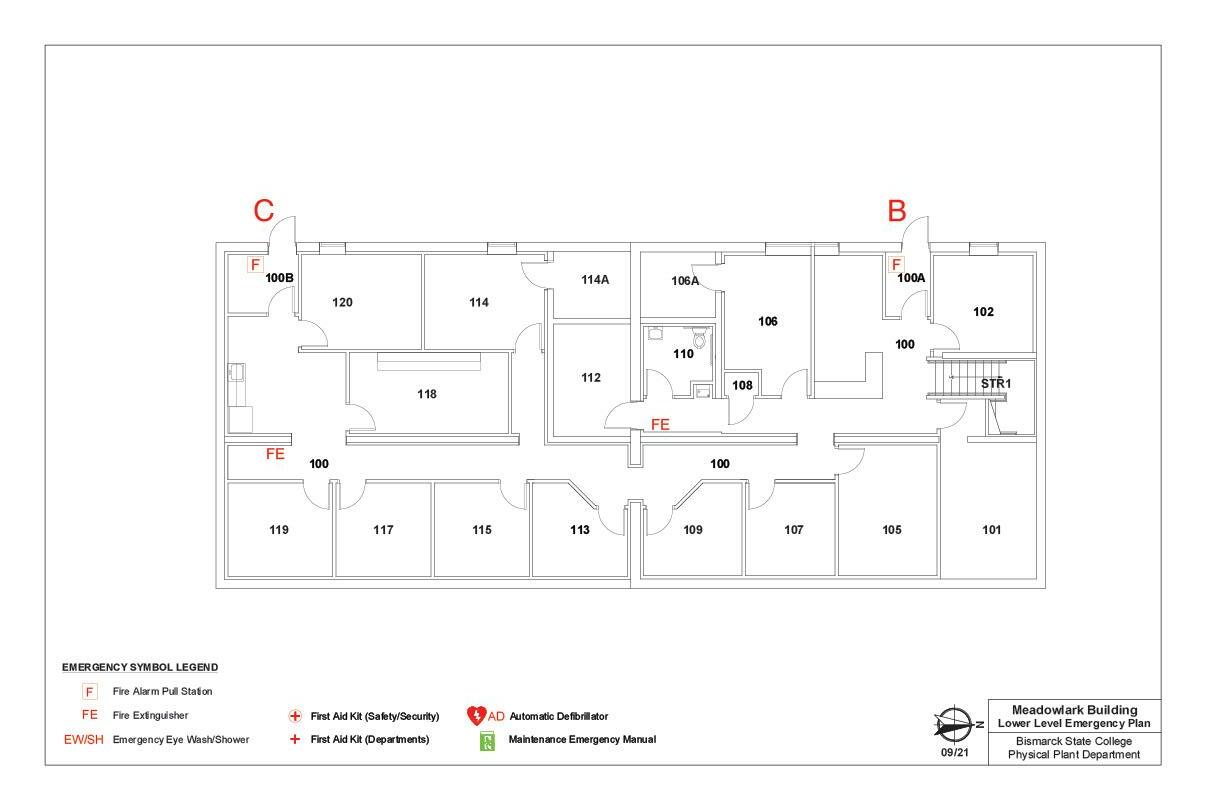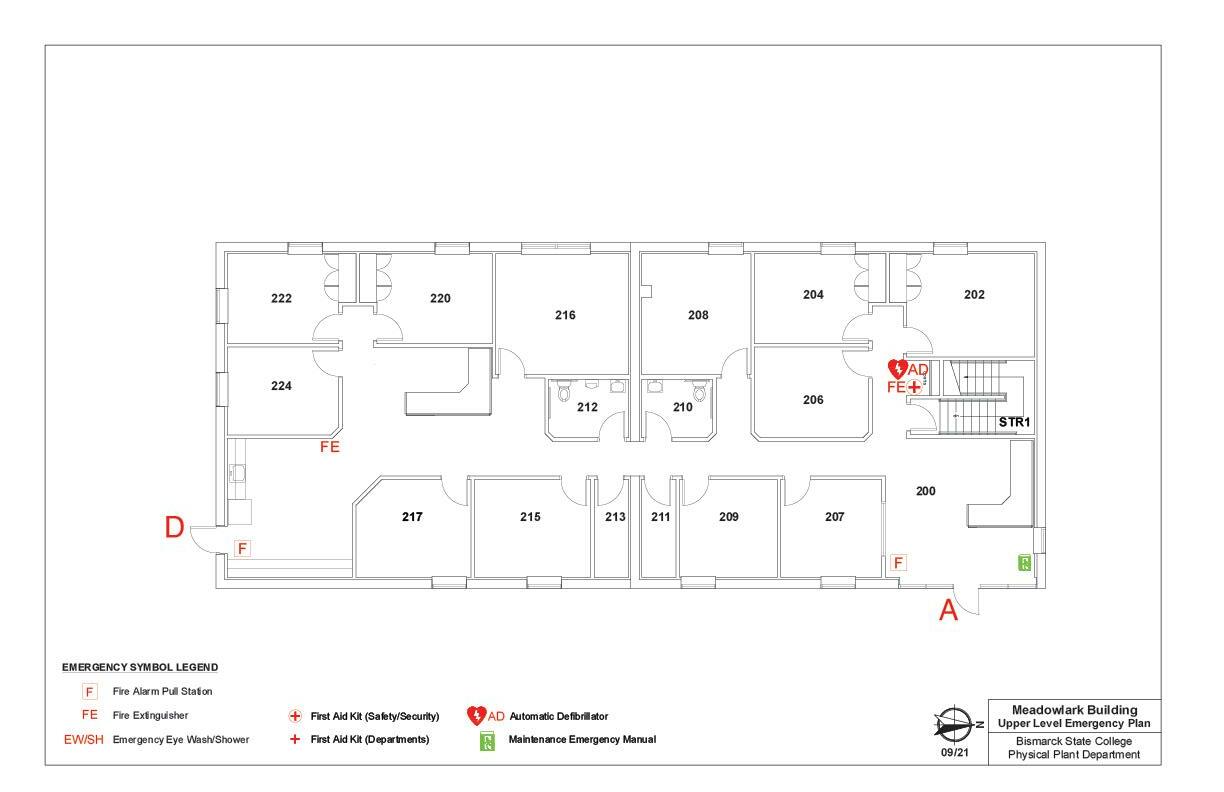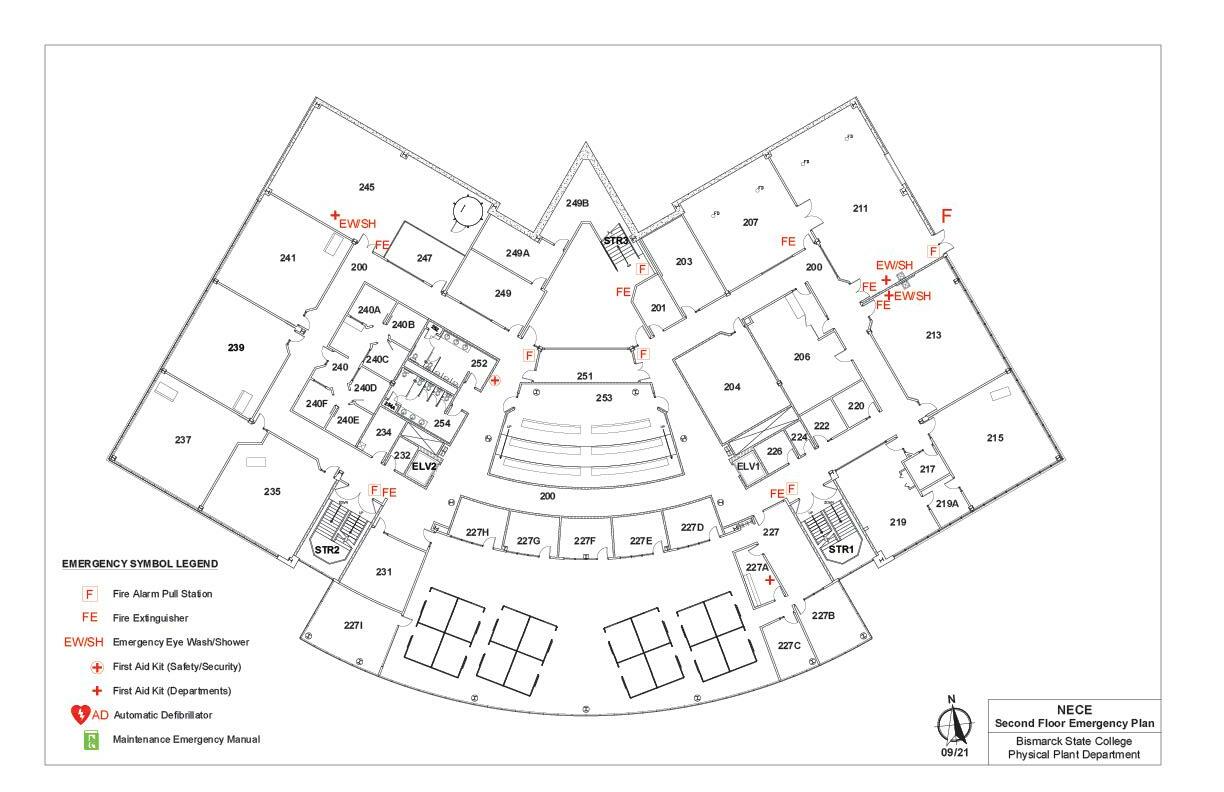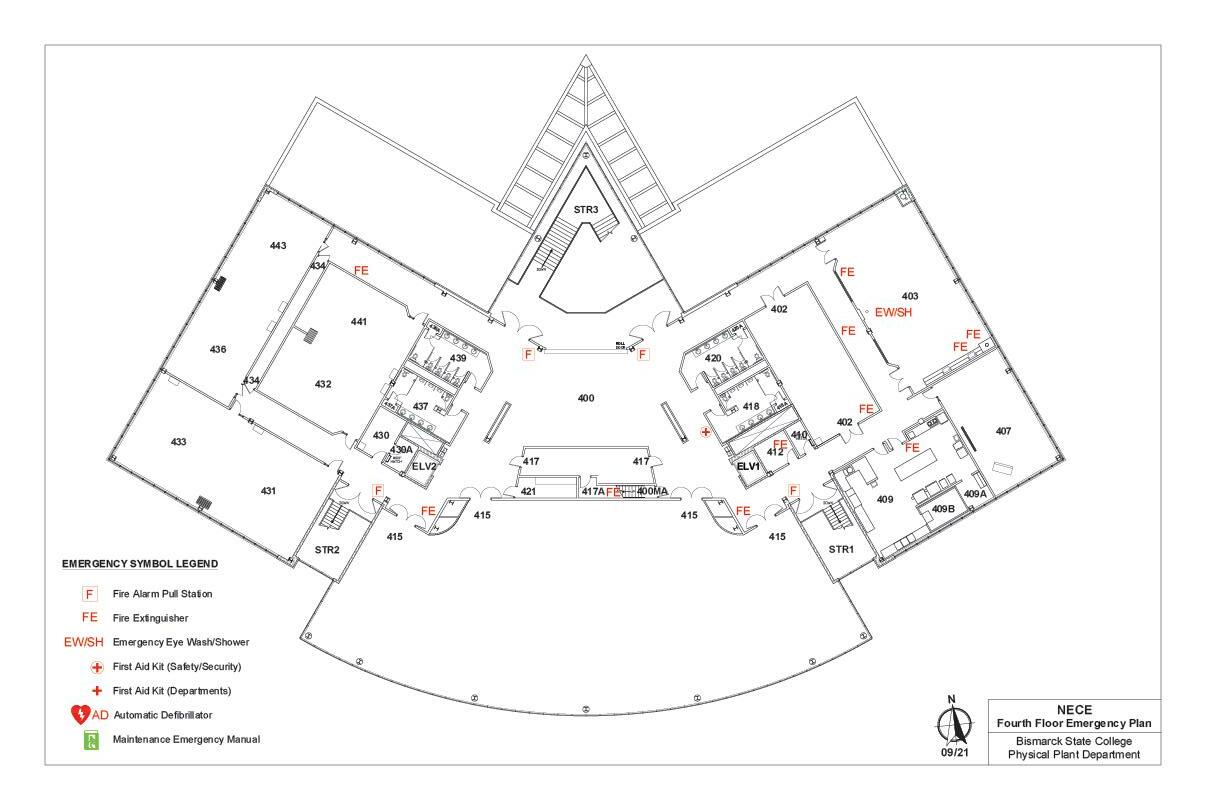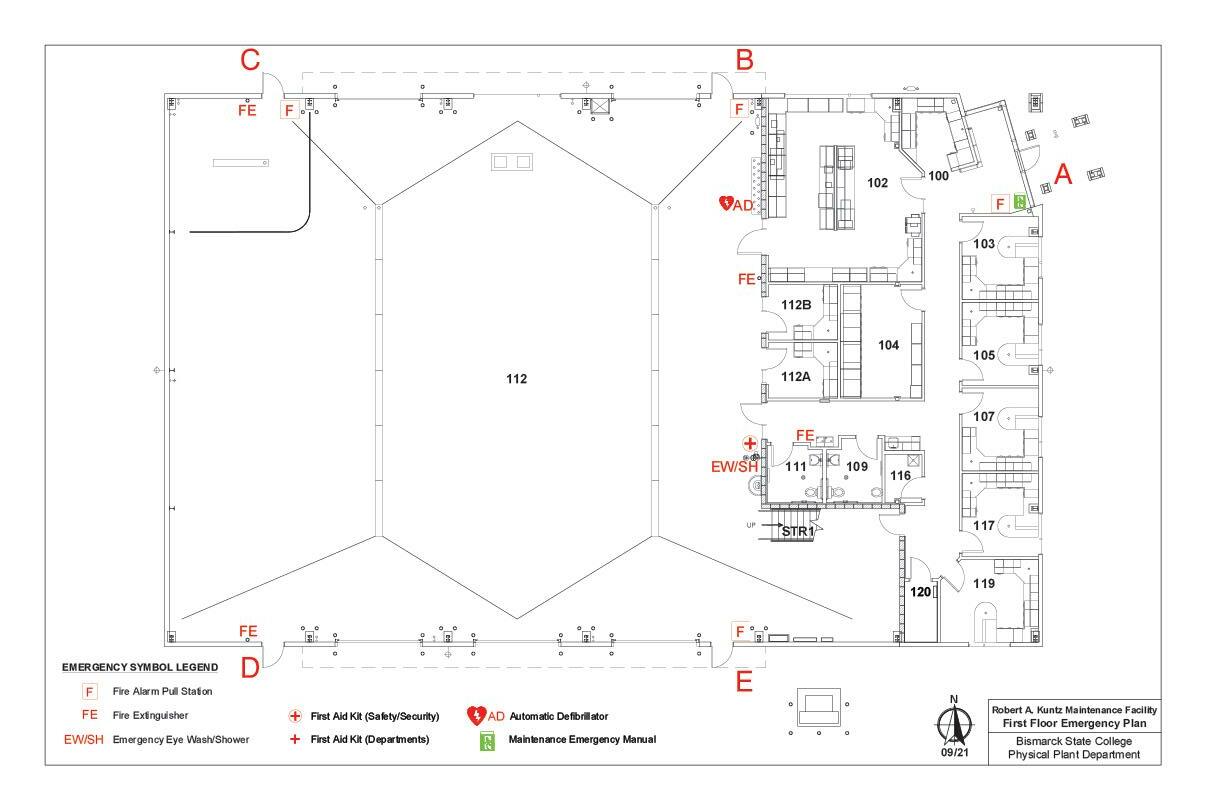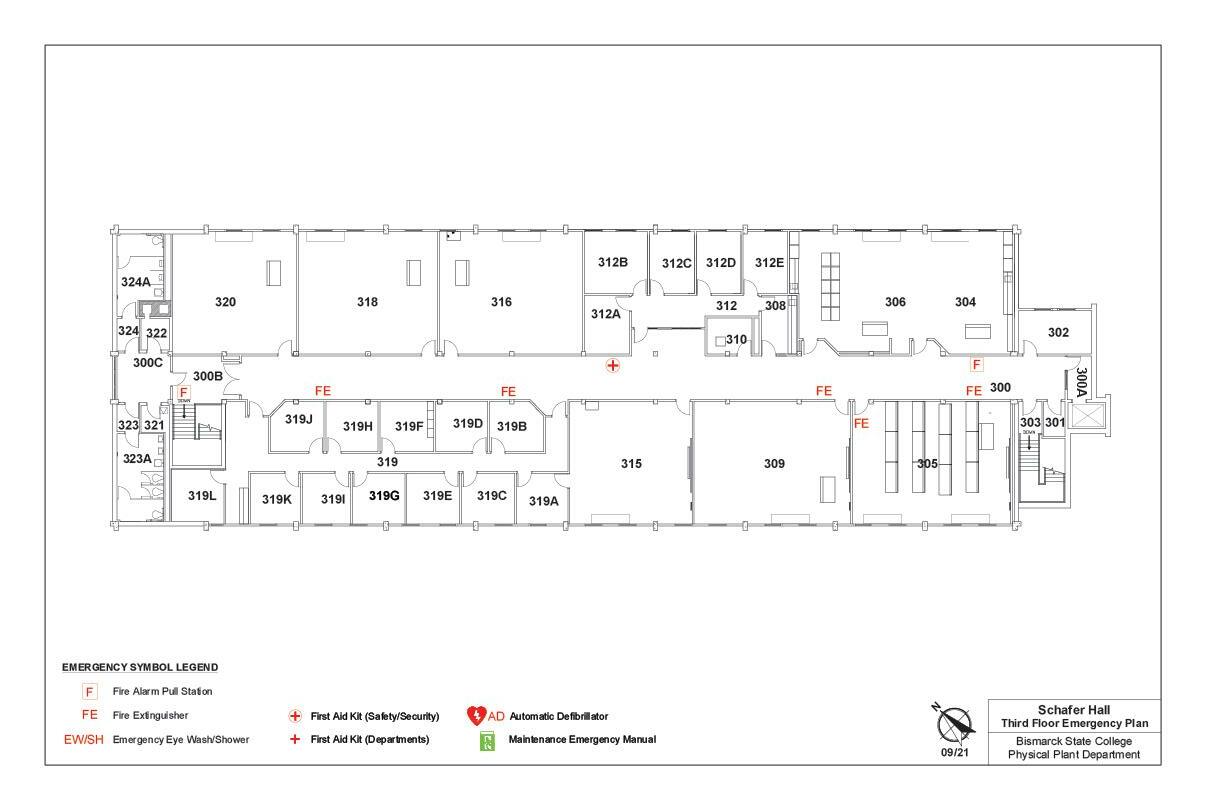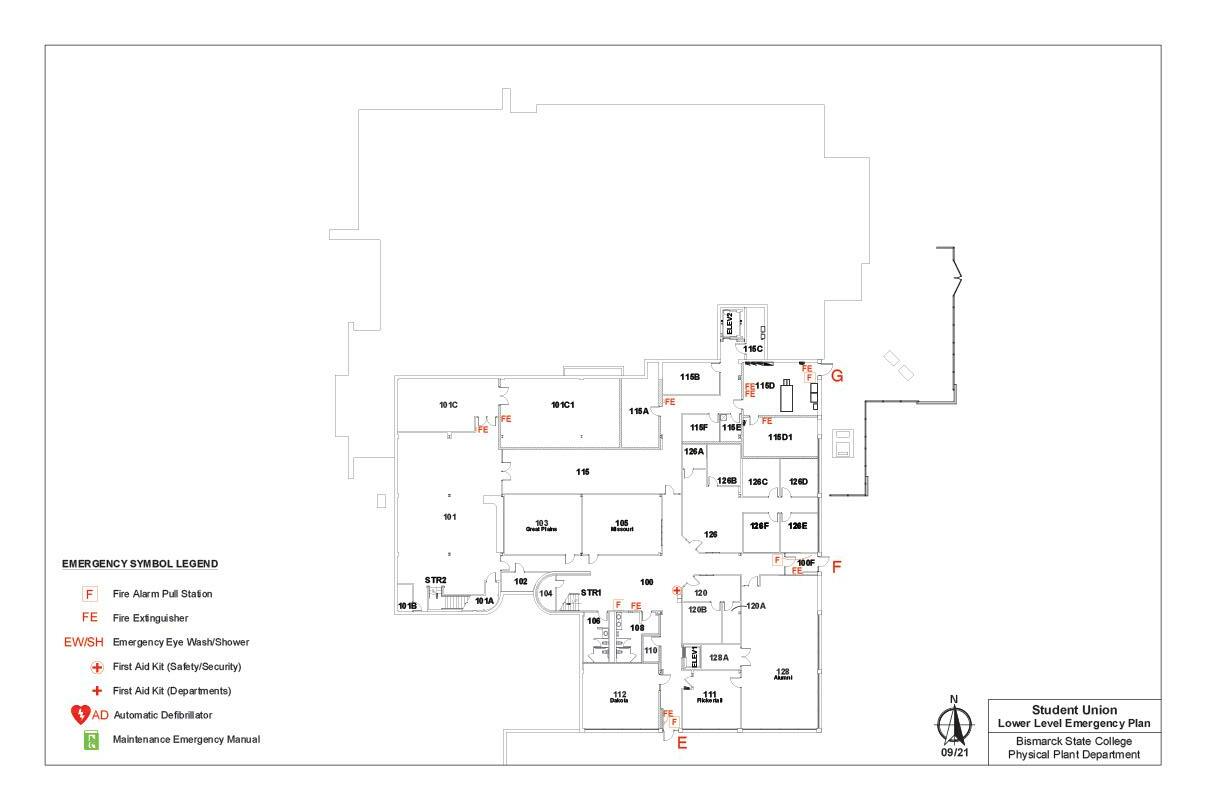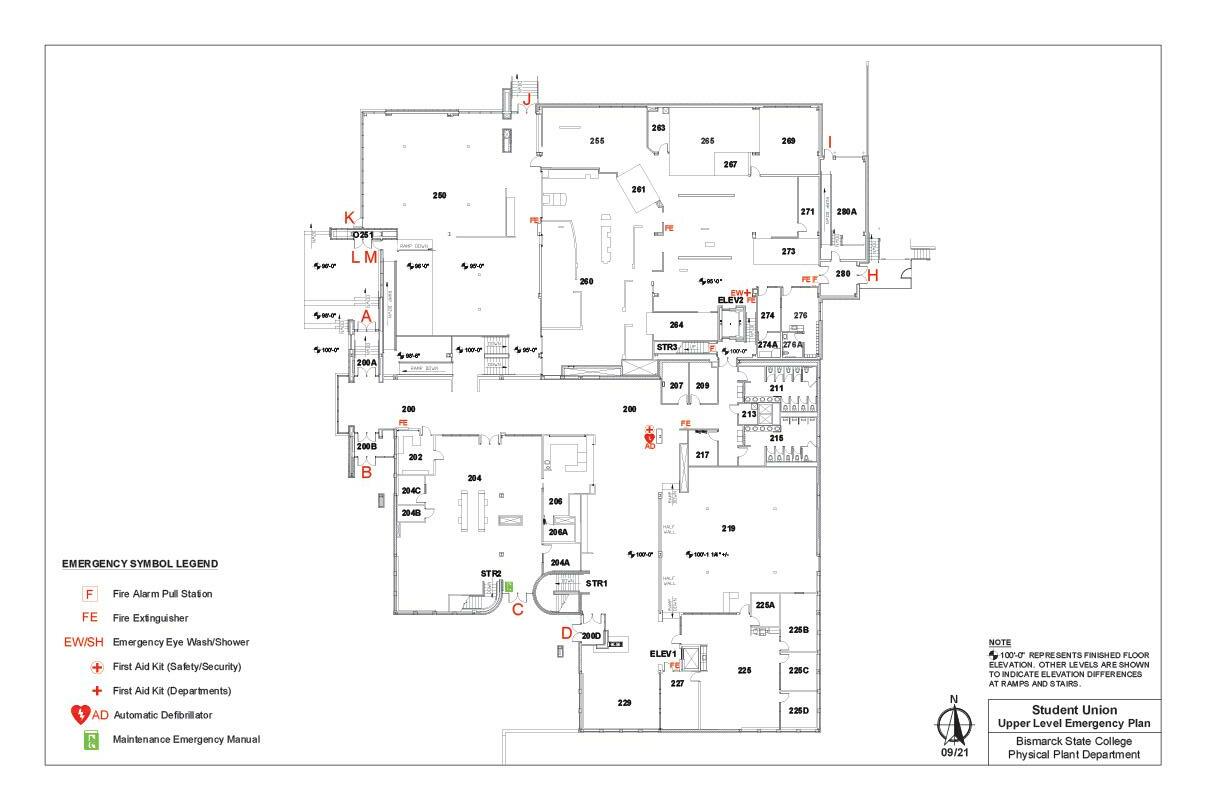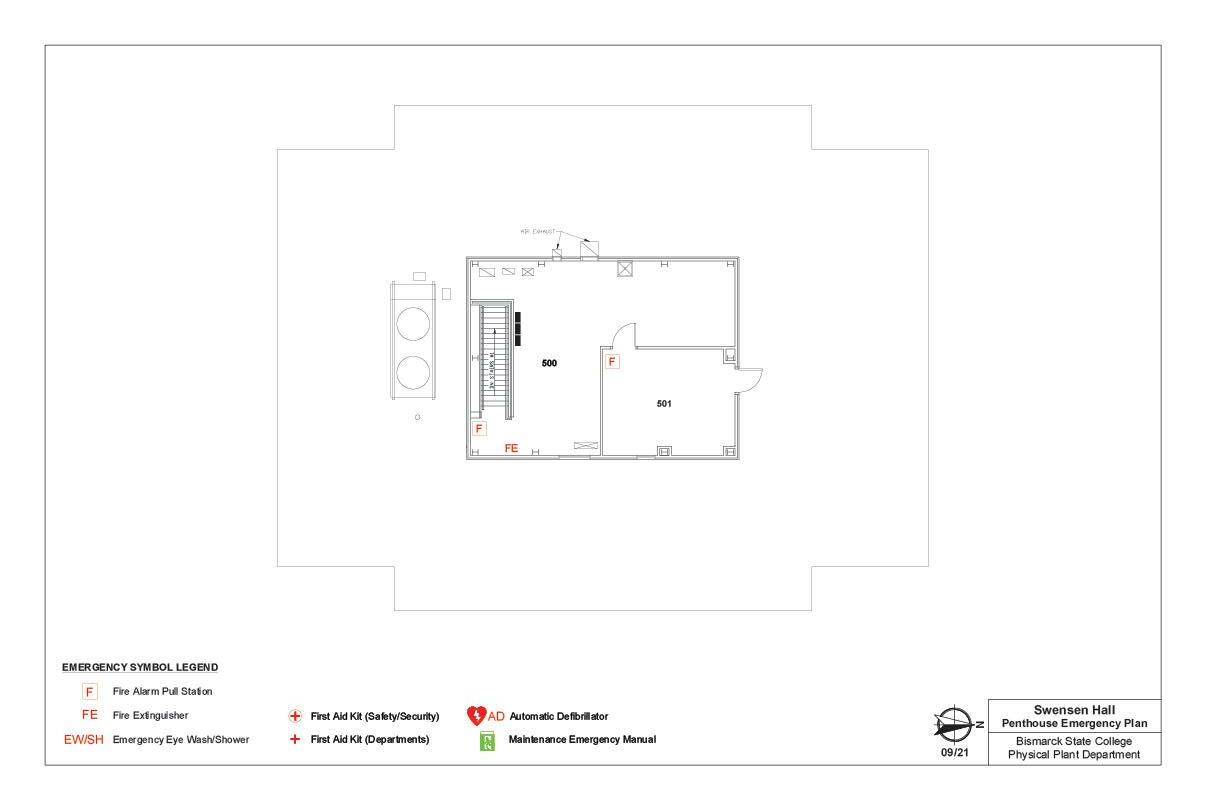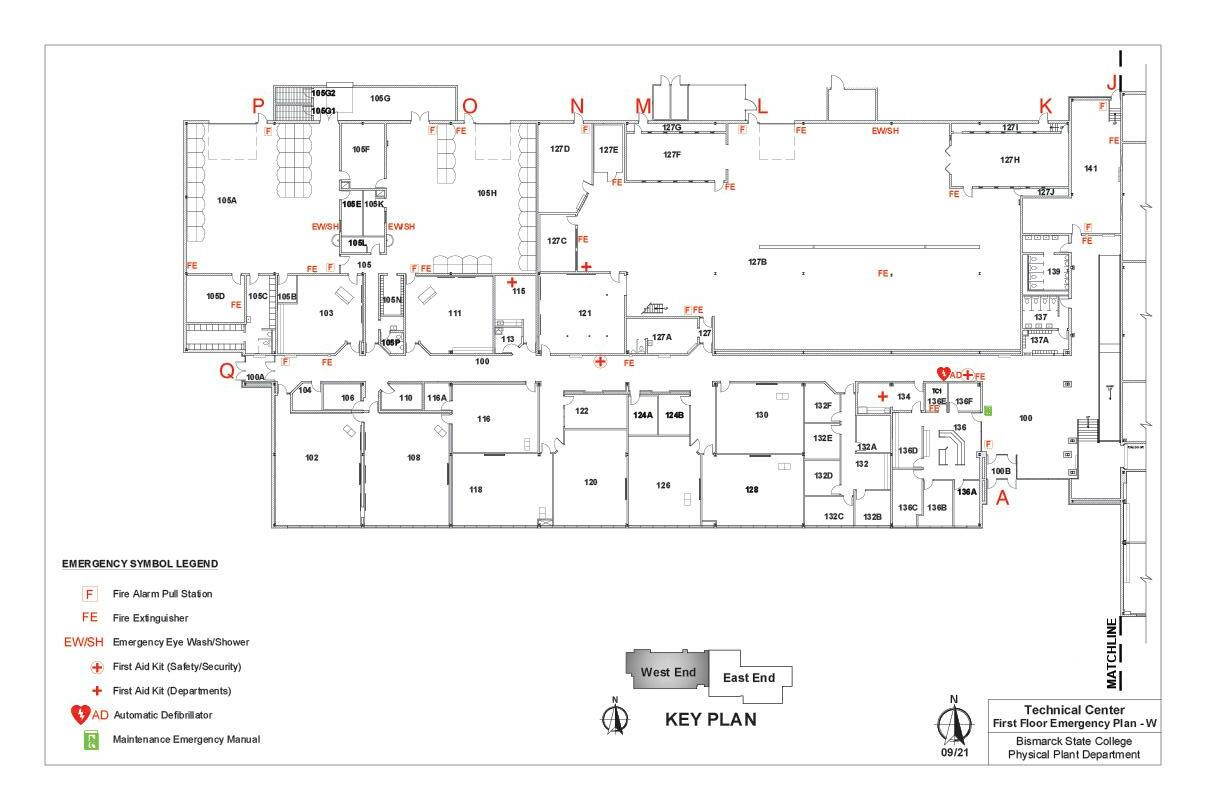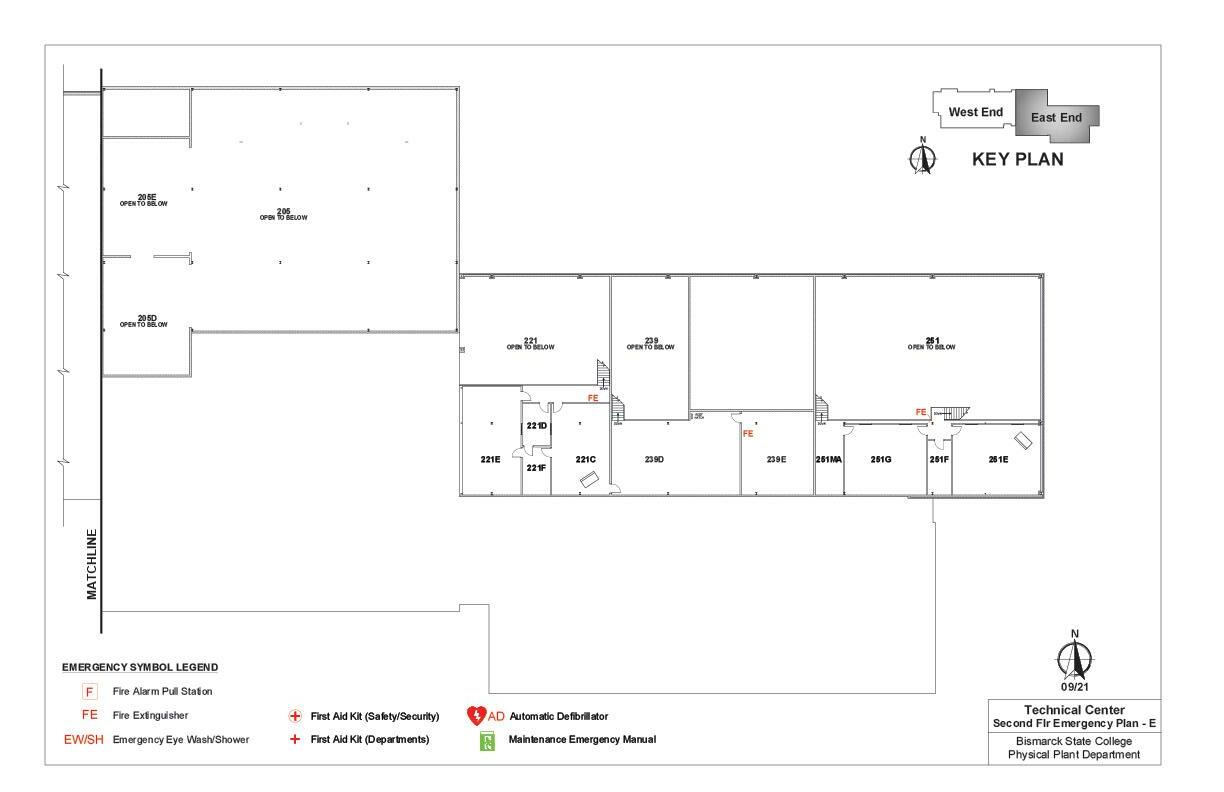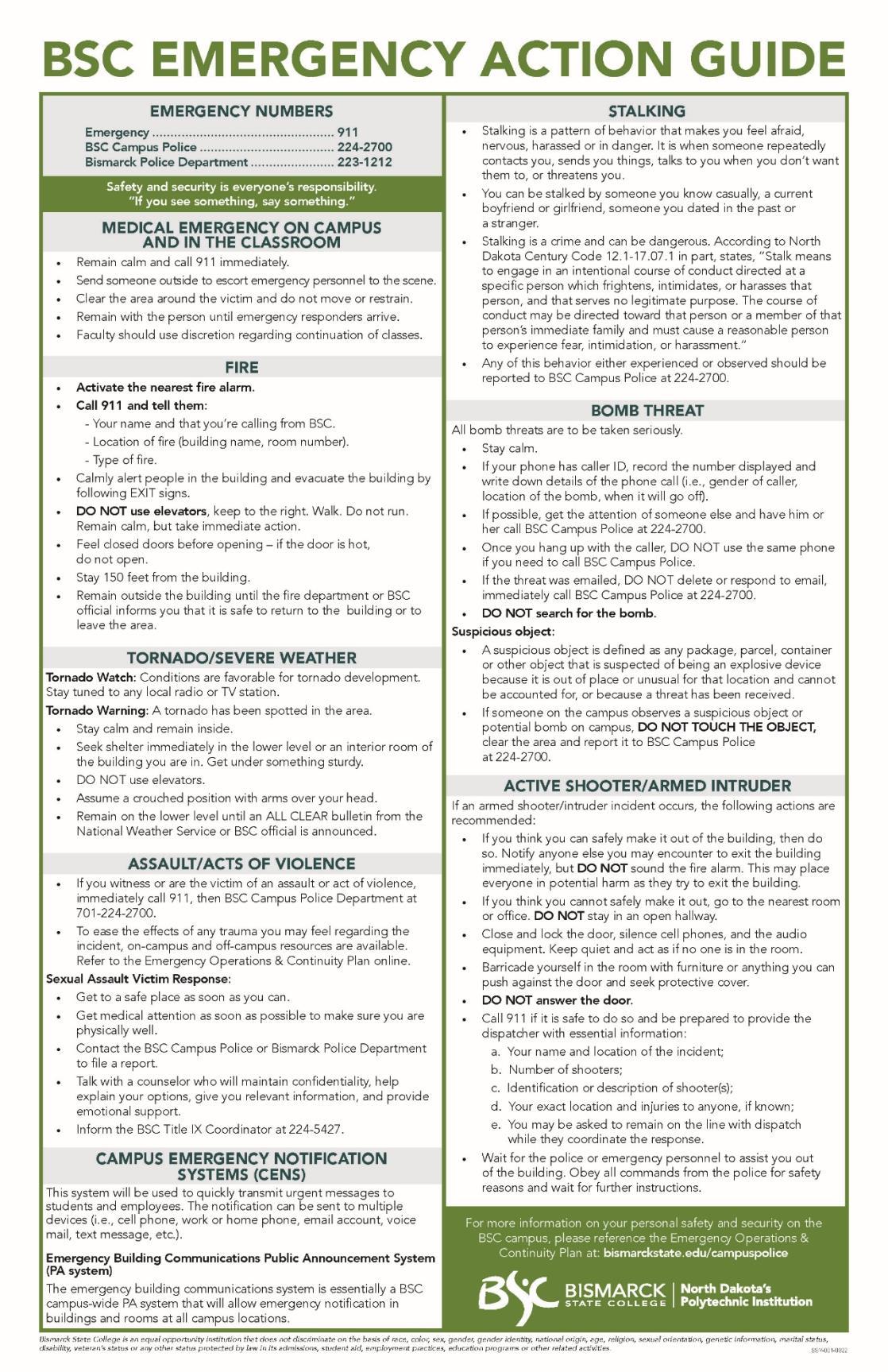Section 2: Organization and Assignment of Responsibilities
2.1 ORGANIZATION FOR PLANNING
The BSC Crisis Management Team reviews and coordinates College-level emergency preparedness plans.
2.2 COLLEGE EMERGENCY MANAGEMENT STRUCTURE
2.2.1 Emergency Activation Levels
➢ Level 1 Emergency:
Campus emergencies (Authorities on campus, Fire Alarms, Supervisory Alarms) which are managed using existing College resources with limited outside assistance and are typically on college property.
Campus Police personnel respond on scene. BSC Buildings and Grounds may respond to certain building specific emergencies. Campus Police Chief will provide updates to Public Relations Manager for dissemination to Policy Group. Crisis Management Team (CMT) may activate. If activated, CMT will determine if the Emergency Operation Center (EOC) will be activated with partial or full staffing. Incident Command may be initiated depending on circumstances.
➢ Level 2 Emergency:
A major emergency that affects an area or building of the College community, may significantly affect life safety concerns, and/or impact mission critical functions.
External emergency resources will likely be required and will assume command of the emergency response effort with input from college resources. The CMT should activate and determine whether the Emergency Operation Center (EOC) should be staffed partially or fully. College Incident Command will be activated to handle internal BSC command functions and may participate in Unified Command with local responders.
➢ Level 3 Emergency:
A disaster, which by nature and impact extends beyond the College, not only disrupting and/or halting operation and functions of the College, but also those of the surrounding community.
BSC Emergency Operations Plan 17
External emergency resources will assume command of the emergency response effort. The College will provide support as requested and able. The CMT will activate, along with the EOC where the CMT will convene. College Incident Command will be activated to handle internal command functions and will participate in Unified Command with local responders.
2.2.2 Emergency Incident Management
To manage emergency incidents, the College utilizes a tiered structure involving a Policy Group and Crisis Management Team (CMT).
The Policy Group, which is formed around the President’s Executive Cabinet, serves as an advisory board for the President and provides strategic guidance during incidents.
The Crisis Management Team (CMT) is drawn from departments or divisions involved in managing emergencies or supporting emergency management. Which may include a group of senior staff members that support BSC students, staff, and faculty, and College operations during and after an emergency incident.
The College will activate the Emergency Operation Center (EOC) any time the CMT is activated for an emergency or disaster and immediately notify the System Office.
2.3 POLICY GROUP
Under the direction of the President or designee, the Policy Group provides direction in making strategic policy decisions for any incident that affects the College’s ability to perform its critical operational functions. This group has the authority to proclaim College emergencies and to issue directives regarding the status and resumption of College educational programs. The Policy Group is also responsible for notifying and informing key College constituents and stakeholders.
The Policy Group is comprised of President, Vice President for Academic Affairs, Executive Vice President Vice President for College Advancement and Executive Director, BSC Foundation, Vice President for Student Affairs, Public Relations Manager, Chief Human Resources Officer and Campus Police Chief.
The President is the senior executive official for the College. In the absence of the President, a designee will assume these responsibilities.
2.3.1 Policy Group Responsibilities
➢ Serves as a strategic planning committee that focuses on policy issues separate and distinct from direct operational response to an emergency or disaster.
BSC Emergency Operations Plan 18
➢ Provides guidance and support to the CMT.
➢ Approves action of the CMT as needed.
➢ Works with the Public Information Officer (PIO) to communicate information to key constituents and stakeholders through various means.
2.4 CRISIS MANAGEMENT TEAM (CMT)
The Crisis Management Team (CMT) is drawn from departments or divisions involved in managing emergencies or supporting emergency management.
The following functions should be included: ➢ Operations ➢ Public Safety/Emergency/Police ➢ Student Affairs ➢ Risk Management
Human Resources ➢ Marketing and Communication ➢ Finance (Emergency Response) ➢ Business Services (Continuity of Operations) ➢ Procurement
➢ Facilities ➢ Executive/Administrative Assistant Support ➢ Information Technology ➢ Campus Emergency Resource Personnel ➢ [College personnel with Fire Science, Homeland Security, Emergency Management, EMT, public safety or similar background]
This group will provide input and advisement to Incident Command staff and/or the BSC Policy Group during an emergency incident.
2.5 CMT AND POLICY GROUP ACTIVATION
The President has designated the Campus Police Chief as chair of the CMT. The CMT will meet to discuss plans and readiness a minimum of twice per calendar year, and will convene as necessary for emergencies, incidents, or large-scale events.
The Policy Group is activated by the President or designee. When activated, the Policy Group will convene at a predetermined location or other location as dictated by the nature of the incident, or as determined by available members of the Policy Group. The Policy Group should establish protocols for convening electronically, as needed.
The CMT is activated by any member of the group after consultation with appropriate Incident Command Staff. The notification will be sent out by either Public Affairs or their designee, members of the Campus Police or other designees.
BSC Emergency Operations Plan 19
➢
A senior on-duty member of the Campus Police may activate the CMT without further discussion by virtue of the likelihood that he/she may be serving as the Incident Commander at any given scene.
When activated, the CMT will convene in the following pre-designated location.
LOCATIONS:
1. Student Union Alumni Room
2. NECE 335 Conference Room
Other locations as dictated by the nature and location of the incident, or as determined by consensus of available CMT members may also be utilized.
2.5.1 Overview of Policy Group and Crisis Management Team Member Responsibilities
• Acts as highest level of campus authority during emergency, crisis or disaster.
President
• Leads Policy Group in making critical policy decisions regarding college response and recovery.
• Maintains logs of significant events related to college finances.
• Works with Incident Command to assess disaster effects campus wide.
• Provides policy guidance.
• Coordinates financial matters.
Chief of Operations: - Executive Vice President
• Works with HR director for allocation of employee reimbursement during emergencies.
• Coordinates financial matters as needed for continuity of operations.
• Determines whether a Request for Payment (RFP), competitive sealed bid, or other methods shall be used for each procurement during an emergency.
• Acts as primary alternate in President’s absence.
• Maintains logs of significant events related to Academic Affairs
Academics:
-Vice President for Academic Affairs
• Works with Incident Command to assess disaster effects on academic areas.
• Serves as lead representative in matters related to academic interface with the EOC operations and academic issues.
• Liaison for instructional services.
• Coordinates class rosters with registrar.
• Responsible for decisions concerning the cancellation, rescheduling, or relocation of classes, tests, and other programs interrupted by an incident.
Alumni and College Advancement:
-Vice President for College Advancement and
• Maintains logs of significant events related to College Advancement
• Responsible for notifying and informing key College constituents and stakeholders.
BSC Emergency Operations Plan 20
Executive Director, BSC Foundation
• Works with College Relations to develop key stakeholder and community messages.
• Maintains logs of significant events related to student services.
• Assesses and coordinates student crisis management and other needs.
• Ensures compliance with Dept. of Education regulations.
Student Affairs: -Vice President for Student Affairs
Campus Police
- Campus Campus Police Chief
• Accountability.
• Liaison with student support services.
• Provides relevant information regarding existing students of concern from disciplinary and behavioral intervention team records.
• Responsible for student tracking and reunification.
• Maintains logs of significant events related to Safety and Security.
• Incident Commander.
• Assists President in leading Policy Group.
• Directs all activities of the CMT.
• Declares and ends the emergency at discretion of President.
• Directs activities of college incident response team.
• Coordinates with external emergency response agencies.
• Reports to incident site as requested.
• Solicits qualified personnel to incident site (traffic and perimeter controls).
• Conducts after-action reviews with Policy Group.
• Maintains logs of significant events related to Human Resources.
• Requests for legal advice from BSC Legal Department on behalf of CMT.
Human Resources
-Chief Human Resource Officer
Public Affairs
- Public Relations Manager
Buildings and Grounds
- Chief Buildings and Grounds Officer
Information Technology Solutions & Services
- Chief Information Officer
• Acts as liaison with state Risk Management.
• Acts as campus safety officers and compiles information needed for the after-action report.
• Responsible for personnel accountability and legal matters.
• Maintains logs of significant events related to media.
• Obtains information and periodic updates from Incident Command.
• Works with President and Incident Command PIO to develop the College’s messages.
• Responsible for information dissemination to college community, public sector, and media outlets.
• Assists with emergency notification.
• Maintains logs of significant events related to Buildings and Grounds.
• Solicits qualified staff members to incident site for utility control, trades, environmental health & compliance, and damage control.
• Technical resource for long-term shelter in place.
• Maintains logs of significant events related to ITSS.
• Assists with emergency notification and equipment.
• Provides support for communications and data management.
BSC Emergency Operations Plan 21
Legal
- System Office General or Associate Counsel
Administrative Support
• Responds to requests for legal advice from the CMT as needed.
• Acts as liaison to Policy Group.
• Serves as a resource person.
• Documents activities and meetings.
• Solicits qualified personnel to incident site.
Emergency Support Group
• Assists Incident Command in interpreting, understanding, and predicting activities of external public safety organizations.
• Functions as Liaison with external public safety agencies
2.6 EMERGENCY OPERATION CENTER (EOC)
Upon activation at Emergency Activation Level 2 (major campus emergency) or Level 3 (disaster that extends beyond campus), the BSC Emergency Operation Center (EOC) serves as the centralized location to monitor and report the impact of emergencies while providing communication between the EOC and the campus, and between the EOC and surrounding jurisdictions. The EOC is the focal point for coordination, direction, and control of emergency preparedness, response, and recovery activities for the campus, and is the location to which EOC will report for duty and assume their EOC roles. Their roles in the emergency response activities, and work assignments will be planned, coordinated and delegated from the EOC.
The primary EOC location is Student Union Alumni Room. The facility is a designated but not a dedicated EOC facility. Supplies are to be maintained in a state of readiness for conversion and activation when needed. Other possible facilities will be determined at the time of activation.
In the event the campus is secured, and access is limited, EOC members may be told to report to an alternate location.
2.6.1 EOC Activation
The EOC may be activated when necessary to facilitate the College’s response and subsequent recovery from any emergency. The Emergency Activation Levels are used to classify the significance of the event. Any member of the Crisis Management Team is authorized to activate the EOC upon approval of the President or designee
In a Level 3 activation, emergency personnel responding to the EOC from off campus should display appropriate identification for access to campus. EOC members are to bring their own Department issued laptops, cell phones, power cords, and chargers (if available) to the EOC.
2.6.2 Notifications
In an emergency, the individual activating the EOC will notify the CMT or contact the Public
BSC Emergency Operations Plan 22
Information Officer or his/her designee, who will give notice to CMT.
A brief message describing the event will be provided for inclusion in the CMT notification. The message will ask for availability and will require a response. When notified of an event requiring EOC activation, personnel should report directly to the EOC. If an individual is unsure about reporting for duty, he or she should contact Campus Police Chief at 701-426-8870.
Whenever the College activates the EOC for Level 3 response, notification will also be made to the appropriate local jurisdiction’s Emergency Operations Center (EOC) if activated and the North Dakota University System Office at 701-328-2960.
2.6.3 EOC Setup
Upon notification of EOC activation, the Administrative Support section will initiate setup. General setup responsibilities include:
➢ Ensure that the EOC is accessible.
➢ Post entry/exit log at EOC entrance and ensure staff sign in as they arrive.
➢ Post communications information including phone numbers of departments.
➢ Establish a “quiet space” where EOC staff can take a break and make private calls.
➢ Continue to monitor EOC operations and logistical needs during the time the EOC is operational.
2.6.4 EOC Security and Access Control
Access to the EOC will be controlled by CMT staff or Campus Police when necessary. Prior to being allowed access, additional staff must be granted authorization from the Chief of Operations, or Incident Commander. All EOC staff must sign in upon arrival and sign out when departing.
2.6.5 Incident Documentation
It is important that the incident be properly documented from the beginning of the incident until the EOC is demobilized. EOC Activity Logs provided for each EOC position to record include:
➢ Initial Briefing Report
➢ Incident Action Plan
➢ Incident Phone Log
➢ Event/Decision Log
➢ Checklists for the position
➢ EOC Deactivation Checklist
➢ After Action/Corrective Action Plan
BSC Emergency Operations Plan 23
Additional documentation will be provided by message forms provided for messages received and sent by the EOC staff, maps generated to support the incident, damage assessment forms, and media releases developed by the EOC or received from other sources.
2.6.6 EOC Deactivation and Demobilization
The Campus Police Chief along with the Policy Group or a designee will determine when to deactivate the EOC and transition to normal campus operations. The process of demobilizing includes demobilizing all staff, documenting the incident in preparation for requests for city/state/federal disaster recovery funds, and documenting the incident in preparation for the After-Action Report and updates to college plans and procedures. To accomplish this:
➢ The EOC Chief of Operations will notify sections when they are no longer required in the EOC.
➢ All staff must ensure that any open actions not yet completed will be handled after the deactivation.
➢ All staff must ensure that all required forms or reports are completed prior to deactivation and have copies made of all logs, reports, messages, and any documents used and received in the EOC. Leave originals in the position folder.
➢ An official notification will be sent to all involved internal and external participants that the EOC is deactivated.
➢ Additional deactivation items are listed in the unit checklists and the EOC Deactivation Checklist.
This action signifies the transition from the response phase to the recovery phase. Prior to deactivation, the Policy Group will assign staff to a Disaster Recovery Group to establish the short-term recovery goals that facilitate long-term recovery. The recovery plan could address one or all of the following:
➢ The recovery effort’s goals
➢ The recovery organization’s structure, including the roles of government, the public, and business in the process
➢ Short-term recovery operations such as debris removal and restoring essential utilities such as water and power
➢ Inspecting facilities for safety, health, and structural integrity
➢ Volunteer and donations management
➢ Economic recovery
➢ Environmental recovery
➢ Financial and community resources
➢ Social and psychological aspects of recovery
BSC Emergency Operations Plan 24
2.6.7 Establishing an Alternate EOC
Depending on the dynamics of an incident, it may be necessary to relocate to another location to perform the EOC functions. The incident may either disrupt the functionality of the primary EOC or it may jeopardize the safety of staff working at the EOC.
The backup EOC locations are NECE 335 Conference room. If this location is damaged or unsafe, a determination will be made by the Incident Commander as to an appropriate location either on campus or off-campus. Notifications will be made to staff and to the external agencies of the new EOC location.
Executive/Administrative Support Group should arrange for the transfer of needed supplies and equipment from the original EOC to the alternate location. This might include:
➢ Computers
➢ Communication equipment ➢ Maps and displays
➢ EOC forms box
➢ Binders with disaster plan
2.6.8 Communications between the EOC and Response Organizations
The EOC must maintain communications with the first responders, external agencies, (e.g., Red Cross), the NDUS Office and other constituents. CMT members will have access to landlines, cellular phones, and the internet as available on campus.
2.7 TRAINING
Training is an integral part of emergency preparedness and response. Leadership and key personnel need to be trained in specific emergency management subject matter to ensure the College’s overall preparedness, and to ensure that college personnel can efficiently and effectively integrate into incident command structures utilized by emergency response agencies.
Relevant training includes, shall be determined by the Policy Group. All members of the CMT shall receive IS-100.c Certification. Other available trainings include:
IS-100.c Introduction to Incident Command System (ICS)
IS-200.c Basic Incident Command System for Initial Response
ICS-300 Intermediate Incident Command System
IS-360 Preparing for Mass Casualty Incidents: A Guide for Schools, Higher Education
IS-363 Introduction to Emergency Management for Higher Education
ICS-400 Advanced Incident Command System
IS-700 An Introduction National Incident Management System (NIMS)
BSC Emergency Operations Plan 25
IS-800.c National Response Framework, an Introduction G-367 Introduction Emergency Planning for Campus G-290 Executives Basic Public Information Officer
2.8 EMERGENCY AUTHORITY
The College President serves as the head of the Policy Group which activates for emergency situations or whenever executive policy issues must be addressed. In the event of any threatened or actual disaster or civil disorder on campus – at a time when the President is absent from campus – the authority to take all necessary and appropriate actions on behalf of the President is hereby delegated to the following College administrators (in the order listed below). Such authority is delegated to the highest ranked College officials on the list with whom the person reporting the emergency is able to make contact:
1. Executive Vice President/Chief Financial Officer
2. Vice President for Academic Affairs
3. Vice President for College Advancement and Executive Director, BSC Foundation
4. Vice President for Student Affairs
5. Chief Human Resource Officer
For a civil disturbance or time-critical situation only, the following personnel Campus Police Chief or his designee; is hereby delegated the authority to take necessary and appropriate actions on behalf of the President when:
➢ Neither the President nor any of the College officials listed above can be contacted within a reasonable time, given the immediacy and other circumstances of the threatened or actual event.
➢ An actual civil disorder or other violent event is in progress and immediate action is necessary to protect persons or property from further injury or damage.
Section 3: Direction, Control, and Coordination
3.1 NATIONAL INCIDENT MANAGEMENT SYSTEM (NIMS)
The National Incident Management System (NIMS) is a structured framework used nationwide for both governmental and nongovernmental agencies to respond to natural disasters and/or terrorist attacks at the local, state, and federal levels of government. The 2003 presidential directive HSPD-5 required all federal agencies to adopt NIMS and to use it in their individual domestic incident management and emergency prevention, mitigation, preparedness, response, and recovery programs and activities. The directive also required federal departments to make
BSC Emergency Operations Plan 26
adoption of NIMS by state, tribal, and local organizations a condition for federal preparedness assistance and in applying for federal grant assistance.
BSC has adopted NIMS as its system of preparing for and responding to disaster incidents. This EOP is part of the overall campus and community emergency preparedness efforts. The procedures and guidance contained herein are subject to and compliant with NIMS and Incident Command System.
3.2 INCIDENT COMMAND SYSTEM (ICS)
The Incident Command System (ICS) is a standardized, on-scene, all-hazard incident management concept that is used by emergency response agencies nationwide to manage incidents of all types, sizes, and complexities. ICS is one component of the National Incident Management System (NIMS), which is a flexible framework of doctrine, concepts, principles, terminology, and organizational processes that apply to all hazards and jurisdictions.
NIMS requires that schools receiving emergency preparedness funding adopt and train personnel in ICS as a condition for receiving that funding.
The Incident Command System:
➢ Uses standardized position titles for all responding agencies.
➢ Allows ICS positions to be filled by the most qualified personnel.
➢ Establishes a modular structure that can be expanded to accommodate large-scale incidents or reduced as an incident winds down.
➢ Uses plain English and common terminology to allow responding agencies to better communicate with one another.
➢ Establishes unity of command, wherein incident personnel report to only one supervisor.
➢ Utilizes a management by objective approach.
3.3 ICS AND BISMARCK STATE COLLEGE
Emergencies and or large-scale events are normally managed with the use of the Incident Command System. ICS has been adopted, recognized and utilized by all emergency response agencies in the surrounding area, the State of North Dakota, and all Federal organizations. If an emergency and/or large-scale event occurs at the College, College resources may be quickly depleted or inadequate for the type of incident (i.e. fire, hazardous materials spill). Local emergency agencies responding to assist will most likely implement ICS to control and manage ongoing operations.
College personnel will support the Incident Command structure and may become part of the system as requested by the Incident Commander or his/her Command Staff.
BSC Emergency Operations Plan 27
3.4 COORDINATION WITH LOCAL AGENCIES
BSC maintains Memorandums of Understanding (MOUs) with local emergency response agencies. MOUs define the assistance and resources agencies are willing to provide during emergency incidents.
BSC maintains MOUs with the following emergency response agencies: City of Bismarck Police Department
Section 4: Communications
4.1 CAMPUS EMERGENCY NOTIFICATION
BSC has implemented emergency notification systems to allow the campus to contact students, employees and other designated individuals or agencies rapidly during an emergency.
4.1.1 Emergency Notification System - Assurance
The emergency notification system will be used for emergencies as defined in North Dakota University System (NDUS)Emergency Notification Systems Policy 1902 This system will be used to quickly transmit urgent messages to students and employees. The notification can be sent to multiple devices (i.e., cell phone, work or home phone, email account, voice mail, text message, etc.).
Definition:
An “Emergency” is defined as a situation that poses an immediate threat to the health and safety of someone in the institution or system community or significantly disrupts the institution or activities of the campus. Examples include active shooter, police-initiated emergency, winter weather closing, fire emergency, tornado warning, hazmat emergency, severe weather alert, bomb threat, and hostage situation.
Employees
1. Mandatory participation in the emergency notification system will be required for all employees (including part-time and student employees).
2. Employees will be required to annually update their emergency notification information.
3. The information required will be campus e-mail and campus phone.
4. Other options for contact information are: home phone, home or work cell phone and text messaging.
Students
BSC Emergency Operations Plan 28
1. All BSC students must participate in the emergency notification system and are required to do so during registration.
2. Students will have the ability to update their contact information in the Campus Connection portal.
3. The portal will allow students to enter campus phone, home phone, cell phone, email, and texting information.
4. BSC will periodically remind students via email to review their contact information.
Collaborative Students and Employees
1. Collaborative (i.e., DSU, MiSU, UND, etc.) students and employees are required to participate in the emergency notification system from BSC and the institution(s) they attend or work for.
Other Designated Individuals or Agencies (i.e. Bismarck Public Schools, ND University System employees)
1. Other individuals or agencies may participate in the emergency notification system as designated by the BSC Crisis Management Team.
EmergencyNotification ProceduresandProtocol:
1. This system has the capability to be activated at any time.
2. The only personnel authorized to approve an emergency message are the BSC President, members of the Executive Council, Public Relations Manager, and the Campus Police Chief or a designated representative(s) of these officials. The designated representative(s) must be identified in writing by the appropriate authorized personnel listed above.
3. Assurance Notification Procedure
• All emergency messages will be initially drafted by the Chief College Relations Officer and Campus Police Chief.
• The President or designee identifies who should receive the message and how it will be disseminated.
• Assurance messages currently available:
o Text
o Home phone
o Cell phone
o E-mail personal and college
4. When an emergency notification message is authorized, it becomes the responsibility of the office or department originating the message to provide any follow-up and/or end of emergency messages for release. It is also the responsibility of the originating office or department to coordinate any media contact through Public Affairs at the time of the notification and/or during the emergency, unless an otherwise designated media protocol is established as part of the BSC Crisis Management Team plan.
5. Emergency notification contact information can be updated within Campus Connection for students and PeopleSoft for employees.
BSC Emergency Operations Plan 29
6. The emergency notification information will be refreshed a minimum of once per semester to allow for the removal of former employees and former students from the system.
7. Because BSC also has a building communications system (PA system), cell phone use for students while in class is left up to the discretion of the instructor.
8. In the event of an emergency, the PA system may be used in addition to the emergency notification system to contact students and employees.
9. BSC Campus Police personnel will administer the test. System tests will be completed on the third Wednesday of each semester at 2pm.
4.1.2 Sample Emergency Notification Messages
WINTER WEATHER - CLOSURE
All Bismarck State College offices and events are closed and cancelled for <Date> due to the impending winter blizzard. All business operations will resume on <Date>.
FIRE ALARM
Due to a fire alarm in the <Building> there was an evacuation of the building. If you are on campus, please proceed with your class or student group to the designated evacuation assembly location in and orderly fashion. Once you have reached the location, please wait for further instructions from BSC Officials.
INADVERTENT FIRE ALARM
On <Date>, a fire alarm was inadvertently activated in <building>... The local authorities responded to the building, investigated the alarm and determined that there was no emergency... We apologize for any inconvenience you experienced and appreciate your understanding.
TORNADO WARNING
The National Weather Service has issued a tornado warning for the <Campus> area… A tornado warning indicates that a tornado has been spotted in this area… We urge you to move away from windows, close your office door, and seek shelter in an interior hallway or stairwell until advised that the emergency has passed. Thank you for your cooperation.
4.1.3 Door-to-Door Notification
If safe to do so, designated college personnel including Campus Police/BSC Police Department and Facilities staff will go to specific rooms and/or wings of the affected campus to alert occupants to an emergency.
4.1.4 EmergencyBuildingCommunicationsSystem(PASystem)
BSC Emergency Operations Plan 30
The emergency building communications system is essentially a BSC campus-wide PA system that will allow emergency notification in buildings and rooms at all campus locations (i.e., Lineworker, and Mechanical Maintenance).
PASystemProceduresandProtocol:
1. In the event of an emergency, the PA system may be used in addition to the emergency notification system to contact students and employees.
2. The only personnel authorized to access the PA System include the Policy Group, Director of Student Residence Life, and Chief Buildings and Grounds Officer.
• The designated representative(s) must be identified in writing by the appropriate authorized personnel listed above.
3. This system has the capability to be activated at any time.
4. BSC Campus Police personnel will assist authorized personnel in administering the tests.
4.1.5 Sample Emergency PA Messages (Repeat Twice)
LOCK OUT– SECURE PERIMETER
Attention, Attention!
The campus is on Lock out. All entrances will be locked. No one should enter or exit until the campus is safe. Be aware of your surroundings. Those inside conduct business as usual.
LOCKDOWN
Attention, Attention!
The campus is on Lock down. Move away from sight and maintain silence. Lock doors. A police officer will come to your location and release you when the campus is safe. Wait for police to open door or wait for the ‘All Clear’.
EVACUATE
Attention, Attention!
An emergency has been reported in the building! Leave the building immediately utilizing the nearest exit. Leave all belongings. Assist those who need help. Avoid using elevators.
SHELTER – TORNADO
Attention, Attention! A Tornado has been sighted near the campus. Evacuate to lowest floor or interior corridors and stay away from glass. This is not a drill.
SHELTER IN PLACE – GENERAL/OTHER
Attention, Attention!
There is an emergency situation occurring that requires you to immediately Shelter in place for (state the hazard) ___________________________
4.1.6 Training
BSC Emergency Operations Plan 31
Training will be conducted annually to ensure that users are comfortable and able to perform the task come said time. Training will consist of:
1. Activation of PA System and conducting of emergency drill to include lockdown, shelter in place, and evacuation.
2. Creating and sending of an Assurance Emergency Notification.
3. Fire alarm drills and PA System drills will be conducted in accordance with the schedule set by Campus Police.
4. PA System will be tested by BSC Campus Police, in each building once a month to ensure they are properly working.
5. All training, drills, and tests of the emergency notification systems will be recorded by the Campus Police Chief.
4.2 PUBLIC INFORMATION OFFICER
Campus and BSC Public Information Officers (PIO) will work with the CMT to disseminate incident-related information to the College community and the general public.
The PIO will work as part of the Unified Command for a coordinated response effort in regard to any large-scale incident that affects the College and its neighboring jurisdictions and requires a multi-agency response.
The PIO will be the primary point-of-contact for media inquiries regarding campus emergencies and incidents. No employee of the College is authorized to speak to the media on behalf of the college without explicit approval from the President or his/her designee.
Section 5: Administration
5.1 AFTER ACTION REPORT AND IMPROVEMENT PLAN
The completion of an After-Action Report and Improvement Plan (AAR/IP) is a part of the College reporting process. It is used to document the College’s involvement in an incident or event to help identify lessons learned and corrective actions.
5.1.1 Protection of AAR/IP Information
The information gathered in the AAR/IP is considered “For Official Use Only” (FOUO) and should be handled as sensitive information not to be disclosed. These documents should be safeguarded, handled, transmitted, and stored in accordance with appropriate College security procedures. Reproduction of these documents, in whole or in part, without prior approval from a member of the Policy Group is prohibited.
BSC Emergency Operations Plan 32
5.1.2 Dissemination
The AAR/IP will be disseminated only on a need-to-know basis. When unattended, it will be stored in a locked container or area offering sufficient protection against theft, compromise, inadvertent access, and unauthorized disclosure.
5.2 PURPOSE OF AFTER-ACTION REPORTS
AAR/IP documents serve the following important functions:
➢ Provide a source for documentation of response activities.
➢ Identify problems/successes during emergency operations.
➢ Analyze the effectiveness of the College’s response components.
➢ Describe and define a plan of action for implementing improvements.
➢ Emphasize the improvement of emergency management at all levels.
➢ Provide a vehicle for documenting system improvements and a work plan for implementing these improvements.
➢ Assist with coordination of the after-action report process when multiple agencies agencies/jurisdictions are involved in the emergency.
5.3 COLLEGE AFTER ACTION REPORT/IMPROVEMENT PLAN PROCESS
5.3.1 Responsibility for After Action Report
➢ At both the field and CMT levels, the planning function is responsible for initiating the After-Action Report process.
➢ At the completion of the emergency period, and after the field ICS and CMT level organizations have been deactivated, Campus Police Chief will assume the responsibility for continuing the After-Action Report process.
➢ Campus Police Chief will assign the After-Action Report to a team as early as possible in the incident to allow establishment of timelines and expedite the preparation of the AfterAction Report.
➢ AAR team members should be familiar with the planning function, emergency organization functions, and NDUS’s policies and procedures.
5.3.2 AAR Documentation
➢ Documentation actions need to be initiated in the early stages of an emergency
➢ Adequate documentation:
o Is essential to operational decision-making;
o May have future legal ramifications;
o May have implications for reimbursement eligibility.
BSC Emergency Operations Plan 33
➢ Documentation should include materials from the planning function and the entire emergency organization. Key components should be identified prior to an incident or event.
➢ Recommended documentation includes:
o Action plans developed to support operational period activities
o Forms used in the College field level Incident Command System
o Unit activity logs and journals
o Written messages
o Function and position checklists
o Public information and media reports
5.3.3 AAR Preparation
➢ Develop a detailed work plan that includes:
o Scope of work
o Work schedules with milestones
o Resource needs
➢ Compile the results of surveys, critiques, and workshops.
➢ Identify and contact key agencies involved in the incident (including primary response agencies and secondary or support agencies) to solicit input for the AAR.
Options may include:
o Prepare an incident-oriented survey to distribute to key agencies.
o Conduct interviews with agency personnel when the initial data gathering process has been completed.
o Conduct a facilitated workshop with key representatives of involved emergency response agencies. The workshop should focus on fact-finding and gathering of pertinent information related to emergency response and recovery activities.
➢ Review, analyze, and sort documentation according to the areas covered in the sample after action report in Figure 1, or another format as appropriate to the organization.
➢ Prepare AAR drafts for review and approval, and distribute to participating agencies, advisory boards, political bodies, and other appropriate interested parties.
➢ Prepare final after-action report and forward it to Vice President for Student Affairs.
BSC Emergency Operations Plan 34
Figure
5-1: Sample After Action Report Outline
BSC Emergency Operations Plan 35
Sample After Action Report Outline
The after action report should follow this structure, but can be adapted to the situation:
Introduction and Background
• Administrative handling instructions
• Table of Contents
Part I: Executive Summary
• Mission/objectives
• General description
• Dates, locations, and major participants
• Significant issues
• Limitations
Part II: Lessons Learned
• Observations
• Discussions
• Lessons learned
• Recommended actions
• Comments
Part III: Events
• Chronology of events
• Operations plan
• Standing operating procedures
• Analysis of capabilities
Part IV: Conclusion
Appendix [ ]: Improvement Plan Appendix [ ]: Acronyms
[If an AAR contains graphics, figures, or tables, they should be numbered and listed in the Contents section (e.g. Figure 1, Table 1, etc.)]
BSC Emergency Operations Plan 36
9.3.2 Evacuation Assembly Locations
In the event that a building must be evacuated, all employees must proceed immediately upon that announcement to the nearest possible exit. All employees should evacuate in an orderly fashion to a pre-designated departmental evacuation assembly location
The evacuation assembly location should be located at a point that is convenient to the building but does not interfere with any emergency response staging.
Employees should remain at the evacuation assembly location until departmental or unit management arrives.
Employees who do not report to the evacuation assembly location are presumed to be still in the building and possibly in need of emergency rescue. In the event of an actual emergency this information should be relayed to emergency response personnel.
The location of the evacuation assembly location should be communicated to new employees during their probationary period.
In the event of a fire drill, all employees should report to the evacuation assembly location as part of the evacuation practice
BSC evacuation assembly locations:
Building Indoor Evacuation Location
Outdoor Evacuation Location
Grass Area north of NECE Foundation House NECE 4th Floor Foyer Grass area west of Foundation Kuntz Building NECE 4th Floor Foyer
Armory NECE 4th floor foyer
Sidewalk south of Werner Hall Career Academy Student Union Marketplace Grass area south of Tech Center Health Sciences Student Union Marketplace
Southeast corner of parking lot Jack Science Center Student Union Marketplace
Sidewalk west of Student Union Lea Hall Student Union Marketplace Sidewalk west of Swensen Hall Leach Music Center Student Union Marketplace Grass area west of Leach Music Center
Lineworker Campus Instructor Discretion
Meadowlark Student Union Marketplace
150 feet from building
Northeast corner of the Jack Science Center parking lot
150 feet from building Schafer Hall Student Union Marketplace Grass area south of Werner Hall Technical Center Student Union Marketplace
Mechanical Maintenance Instructor Discretion
Sidewalk north of Student Union Student Union Technical Center Grass area south of Technical Center
NECE Armory Grass area east of Tennis Courts
BSC Emergency Operations Plan 42
9.3.3 Faculty and Staff Responsibilities
➢ If possible, keep students together in a group during the evacuation and stay with them.
➢ Account for all students present upon reaching the evacuation assembly location.
➢ Immediately report any students you believe to be missing to BSC Campus Police or local law enforcement or fire department.
9.3.4 Directed Building Evacuation (Non-Fire Emergency)
Directed Evacuation is used to get occupants out of the building by a route designed to avoid contact with a potential threat, such as a suspicious package or a hazardous material spill, or if usual evacuation routes are blocked.
Directed evacuation procedures are the same as general evacuation procedures.
Instructions for a directed evacuation will be provided via the public address system or other appropriate communication.
9.3.5 Building Evacuation for People with Disabilities
People with disabilities or mobility impairments should plan for emergencies by developing an evacuation strategy and sharing it with staff, faculty, and fellow students who can assist them with evacuation. People with service animals should practice evacuating so that their service animal becomes familiar with both primary and alternate evacuation routes.
Some individuals with mobility impairments utilize special equipment such as wheelchairs, braces or crutches to move around the campus. Others whose impairments are less visible may have decreased coordination or stamina and may need to move at a slower pace or rest frequently.
During an emergency situation, those persons requiring assistance should be consulted regarding their needs prior to assisting them. The suggestions listed below may vary depending on the emergency situation and the needs of the person requiring assistance.
To evacuate people with mobility impairments:
➢ Assist and accompany to evacuation site if possible.
➢ Use a sturdy chair (or one with wheels) to move the person.
➢ Help carry individual to safety if possible, or use an evacuation chair (stair chair) (see section 9.3.5 below).
➢ Utilize rescue chairs where available to navigate stairs.
BSC Emergency Operations Plan 43
➢ If unable to assist a person with mobility impairment, notify Safety and Security or emergency responders.
To evacuate people using wheelchairs:
➢ Consult the individual before moving him/her.
➢ Individuals at ground floor locations may be able to exit without help.
➢ Utilize evacuation chairs (stair chairs) where available to navigate stairs (see section 9.3.6 below).
To assist people with visual impairment:
➢ Announce the type of emergency.
➢ Take directions from the individual about how best to guide him/her.
➢ Tell the person where you are going and what obstacles you encounter.
➢ When you reach safety, ask if further help is needed.
To alert people who are deaf or hard of hearing:
➢ Turn lights on/off to gain person’s attention.
➢ Indicate directions with gestures.
➢ If time permits, write a note with evacuation directions.
➢ Escort the person out of the building if requested to do so.
To assist people with service animals:
➢ A service animal may become hesitant or confused during an emergency. Discuss how to best assist the person with a disability if this should occur.
9.3.6 Emergency Evacuation Chairs (“Stair Chairs”)
Three collapsible emergency evacuation chairs are installed on BSC’s main campus to assist with evacuation of people with disabilities. Although emergency evacuation chairs are designed to be guided by one person, seek assistance from others. Emergency evauations chairs are located at:
National Energy Center of Excellence
4th Floor, Southwest Stairwell
Jack Science Center
3rd Floor, Northwest Stairwell
LEA Hall
3rd Floor, Central Stairwell
BSC Emergency Operations Plan 44
9.3.7 Building Evacuation Signage
Emergency Exits are to be physically marked by illuminated EXIT signs or similar indicators over each doorway.
Emergency Exits are to be indicated on floor plan maps located in hallways at each campus and in classrooms.
Appendix D of the EOP provides maps of all campus buildings that show emergency exit locations.
9.4 SHELTER
Building occupants may be directed to shelter for situations such as severe weather or an outside hazardous material spill. The nature and location of the incident will determine the extent of shelter-in-place actions.
In all instances, be prepared to evacuate the building or relocate to another area within the building. Listen for instructions via the public address systems, and follow the direction of College or first responder personnel.
9.4.1 General Shelter Procedures
For severe weather:
➢ If safe to do so, close blinds and curtains on exterior windows.
➢ Move away from exterior windows.
➢ If possible, seek shelter in a lower-level interior room with no windows, restroom, or a Designated Shelter Area.
For incidents involving hazardous materials outside the building:
➢ Close doors and windows.
➢ Seal doors and windows with tape if available.
9.5 LOCKDOWN
A lockdown may be ordered for a human threat such as an active shooter. In a lockdown situation, all exterior doors to a building are secured and occupants are expected to remain inside.
BSC Emergency Operations Plan 45
➢ Stay calm.
➢ Remain in classrooms or offices. If in a common area, stay away from windows and doors.
➢ Lock doors and barricade them if possible.
➢ Do not allow anyone access once the doors are locked, as this may compromise the safety of those inside.
➢ Do not allow anyone to talk their way inside, as he/she may be the suspect or may be coerced by the suspect outside of your view.
➢ Wait for further instructions and do not allow anyone to leave until given the “all clear” signal or message.
➢ If you are unable to find a secure room, consider self- evacuation from the building
Individuals who may be on the outside of buildings during a lockdown should move away from the affected area (indicated by the presence of emergency personnel and equipment).
9.6 LOCKOUT
A Lockout moves people into a building from the outside or keeps people in the building away from a threat outside of a Campus. A Lockout may be ordered in the event of a threat such as police chase in the area or wild animal that poses potential danger.
9.7 CAMPUS EVACUATION
A campus evacuation is used to get students, faculty and staff off of campus due to a serious emergency in the area.
When leaving campus, drive with caution, be courteous, and follow directions from emergency personnel. Do not block access/egress for emergency vehicles.
Section 10: Specific Emergency Procedures
ABDUCTION
Call 911 from any campus phone or available cell phone. Provide as much information as possible, including:
• Victim description:
BSC Emergency Operations Plan 46
o
o
o
o Name
Sex
Age
Height
o Weight
o Hair color
o Identifying marks such as tattoos or scars
o Top clothing (jacket and/or shirt)
o Bottom clothing (pants, shorts, shoes, etc.)
• Suspect description:
o Race o Sex o Height o Weight o Hair color
o Identifying marks such as tattoos or scars
o Top clothing (jacket and/or shirt)
o Bottom clothing (pants, shorts, shoes, etc.)
• Suspect vehicle: o Make o Model o Color o License plate state and number
o Identifiable decals or markings on the vehicle
• Time and location of abduction.
• Do NOT attempt to detain the person.
• Ask any witnesses to remain until Campus Police arrives.
ACTIVE SHOOTER
Call 911 from any campus phone or available cell phone.
Active shooter incidents are unpredictable and evolve quickly. A shooter will not stop firing until his/her objectives have been met or he/she is engaged by law enforcement. Each situation is different and will change rapidly. Staff, faculty, and students must be responsible for their own safety until additional law enforcement and first responders are available to aid
Law enforcement officers responding to the incident will first focus on containing/eliminating the threat.
There are three options during an active shooter incident: Run (get out), hide (hideout), or fight (take out).
Run (Get Out)
• Leave the area if it is safe to do so, moving away from the shooter’s location.
• Have an escape route and plan in mind.
BSC Emergency Operations Plan 47
• Leave your belongings behind.
• Help others escape, if possible.
• Keep your hands visible.
• Prevent people from entering an area where an active shooter may be.
• Call 911 as soon as it is safe to do so.
Hide (Hideout)
• Hide in an area out of the shooter’s view, and behind large items that provide concealment and protection from gunfire.
• Block entry to your hiding place and lock the doors.
• Do not trap or restrict your options for movement, if necessary.
• Turn off lights, computer monitors, and radios. Close blinds.
• Silence all cell phones and pagers.
• Stay calm, quiet, and out of sight.
• Unless you are in imminent danger from fire, ignore any fire alarms sounding but stay aware of your surroundings. Active shooters may pull fire alarms in an attempt to shoot people as they exit the building.
• If you are in a safe location and not in harm’s way, do not leave your hiding place until directed to do so by law enforcement officials.
• Keep your hands in plain view at all times for police officers. Follow directions exactly and carry nothing that could be mistaken for a weapon.
Fight (Take Out)
• As an absolute last resort, and only when in imminent danger, attempt to disrupt and/or incapacitate the shooter.
• Throw items and improvise weapons from available objects.
• Hit, kick, or tackle the shooter if close enough.
• Act with physical aggression.
• Commit to your actions.
What to expect from emergency responders:
• The first responding law enforcement officer(s) will not stop to aid the wounded or injured. Their primary mission is to contain the threat.
• Medical and rescue teams will begin treatment of the injured only after the area is declared safe by law enforcement personnel.
• Law enforcement may relocate building occupants to a safe area or may instruct occupants to remain where they are.
After the incident:
BSC Emergency Operations Plan 48
• After evacuation, you may be taken to a holding area for medical treatment, interviewing, and/or counseling.
• Law enforcement personnel may detain you as a witness to the incident.
• You may be asked to provide statements to law enforcement right away, or at a later time.
• The entire area will be treated as a crime scene.
• Once you have been evacuated, you will not be allowed to re-enter the building.
• Information will be released to the BSC community as soon as possible.
AED (AUTOMATED EXTERNAL DEFIBRILLATOR) – CARDIAC ARREST
Call 911 from any campus phone or available cell phone.
An automated external defibrillator or AED is an electronic device that delivers an electric shock to the heart of a person in cardiac arrest. The AED is a “smart” device and will only deliver a shock when it is needed. Anyone can use an AED since the device gives verbal instructions for each step of the process.
An AED should be used when a person collapses or becomes unconscious, is unresponsive to shaking or shouting, has no pulse and isn’t breathing.
• If a person is unconscious and unresponsive to shaking or shouting, send someone to call 911 and to retrieve one of the AEDs. ( AED Locations can be found in Appendix C.) Note: An alarm will sound when the AED is removed from its cabinet.
• Check the patient for respirations and pulse. If the patient is not breathing and has no pulse, begin cardiopulmonary resuscitation (CPR).
• Open the lid of the AED to activate the verbal instructions. Stay calm and follow the instructions until emergency medical personnel arrive.
AIRCRAFT ACCIDENT/CRASH
Call 911 from any campus phone or available cell phone. Depending on the type and location of an aircraft crash on or near a campus, students, staff, and faculty may be directed to:
• Evacuate the building;
• Relocate to another location within the building, or to another building;
• Remain inside the building until the situation is stabilized; or
• Evacuate the campus.
During the incident:
• Avoid the crash site.
BSC Emergency Operations Plan 49
• Keep roads and driveways clear for emergency responders.
• Be aware of the potential for secondary fires and explosions.
• Disturb aircraft debris only to assist victims, and only if it is safe to do so.
ASSAULT/RAPE
Call 911 from any campus phone or available cell phone.
• If the suspected assailant is still in the area, get a physical description and provide it to police: o Race o Sex o Height o Weight o Hair color
o Identifying marks such as tattoos or scars
o Top clothing (jacket and/or shirt)
o Bottom clothing (pants, shorts, shoes, etc.)
• If possible, also provide any vehicle description that may assist police with locating the suspect: o Make o Model o Color
o License plate state and number
o Identifiable decals or markings on the vehicle
• Do NOT attempt to detain the suspected assailant.
• Take the victim to a quiet area and ask him/her to remain until the arrival of Campus Police.
• Assign a staff member to stay with the victim.
• Calmly explain to the victim that showering or cleaning up before a police officer makes contact will compromise or destroy evidence.
SIGNIFICANT BEHAVIORAL PROBLEMS
Call 911 from any campus phone or available cell phone.
• Tell the dispatcher the location or last known location of the person.
• Provide a physical description of the person:
o Race o Sex o Height o Weight
BSC Emergency Operations Plan 50
o Hair color
o Identifying marks such as tattoos or scars
o Top clothing (jacket and/or shirt)
o Bottom clothing (pants, shorts, shoes, etc.)
• If possible, also provide any vehicle description that may assist police with locating the person:
o Make
o Model
o Color
o License plate state and number
o Identifiable decals or markings on the vehicle
• Do NOT attempt to detain the person.
• Ask any witnesses to remain until law enforcement arrives.
BOMB THREAT
Call 911 from any campus phone or available cell phone to report any bomb threat received at, or targeted at, a campus or facility.
Each bomb threat that is directed at any campus facility will be evaluated and responded to as a legitimate and real threat to the College. The safety and well-being of students, staff, and faculty will be paramount. The College’s goal will be to resolve the situation and return to normal operations at the earliest possible time with minimal disruption.
Response procedures will vary with each bomb threat. Deviations to standardized procedures are expected based on variations in the nature of the threat, the specificity of the threat, and the threatened location.
Bomb Threat Received via Telephone
• Enter all aspects of the call on the Bomb Threat Reporting Checklist (see page 57).
• Immediately call 911. Then notify Campus Police, who will, in turn, notify appropriate college administrators and continue with Bomb Threat Standard Operating Procedures if a threat is determined credible.
• Students, staff, and faculty may be ordered to evacuate the building in the event of a credible threat.
Bomb Threat Received via Text Message or Social Media
• Immediately report the threat by calling 911.
• Read bomb threat message to the dispatcher exactly as written.
BSC Emergency Operations Plan 51
• Report the identity of the sender, the date and time the e-mail was received, who the message is intended for, who received carbon copies, and the subject line from the email message.
• Do not respond to the sender.
• Do not delete the bomb threat message.
• Print a copy of the bomb threat message, if possible.
• Meet with responding officers to provide any additional information or answer any questions they may have regarding the email.
• Employees and students should follow the directions of emergency response personnel regarding necessary announcements or evacuations.
Evacuation
Any evacuation ordered due to a bomb threat is mandatory. All occupants of the area being evacuated shall immediately move towards a safe exit and remain outside the area until Campus Police determine it is safe to re-enter.
• Students will take all personal property with them.
• Staff and faculty will inspect for, but not disturb, unusual objects as they depart classrooms and work areas.
• Notify Campus Police of any suspicious or unusual object.
• Do NOT touch, move, or tamper with any suspicious item.
• Students, staff, and faculty will assemble at least 500 feet from the building, or at a designated evacuation assembly location.
• Do NOT use cell phones or portable 2-way radios within 300 feet of a building suspected of containing an explosive device.
• Don’t re-enter the building until notified by emergency personnel.
• If it is determined that a sweep for evidence/devices is necessary, employees may be asked to conduct a sweep (with authorized police personnel) in areas where they are most qualified to identify items that do not belong.
CIVIL DISTURBANCE/RIOT
Call 911 from any campus phone or available cell phone.
In the event of a civil disturbance, Campus Police will isolate the area where the incident is occurring and coordinate activities with law enforcement agencies assisting with the incident.
Depending on the nature and extent of the incident, students, staff, and faculty may be directed to:
• Evacuate the building;
• Relocate to another location within the building, or to another building;
BSC Emergency Operations Plan 52
• Remain inside the building until the situation is stabilized; or
• Evacuate the campus.
CRIMINAL ACTIVITY
Call 911 from any campus phone or available cell phone.
Criminal activity may include, but is not limited to:
• Assault
• Burglary
• Robbery • Theft
• Use or possession of illegal drugs or alcohol on campus
• Illegal possession of a weapon on campus
• Vandalism
Provide as much information as possible to dispatcher, including:
• Suspect description: o Race o Sex o Height o Weight o Hair color o Identifying marks such as tattoos or scars o Top clothing (jacket and/or shirt) o Bottom clothing (pants, shorts, shoes, etc.)
• Suspect vehicle: o Make o Model o Color o License plate state and number o Identifiable decals or markings on the vehicle
• Time and location of activity.
• Do NOT attempt to detain the suspect.
• Ask any witnesses to remain until law enforcement arrives.
CYBERSECURITY
ReportingofSecurityIncidents:
Any student, faculty or staff who become aware of a security incident must take prompt action. Minor incidents should be reported to the Help Desk. Major incidents to the employee’s direct supervisor and the Chief Information Officer. Students should contact the Help Desk who will in
BSC Emergency Operations Plan 53
turn report incident information to the Chief Information Officer. The CIO will make the decision whether the ISIRT must be activated.
Minor incidents (insignificant or low impact)
• Should be reported to the Help Desk
• Measures to contain the incident and analyze the cause
• Corrective actions to eliminate the issue
Major incidents (medium, high or severe impact)
• If a major incident is reported, the response should follow the steps outlined below from the National Institute of Standards and Technology (NIST)
• If a major cyber incident involving the breach of more than 500 records, the Office of Management and Budget (OMB) Risk Management must be notified immediately.
NIST Incident Lifecycle

Source: NIST SP 800-61r2
Incident Response Phases
NIST Special publication 800-61r2 outlines the following phases of an incident: 1. Preparation
Detection and analysis
Containment, eradication and recovery
Post-incident activity
Even though the Information Security Incident Response team is not responsible for prevention, the incident response plan is part of the prevention phase from a governance perspective, providing guidelines to prepare the team for a security event.
Preparation: Communication
Contact information within and outside the college will be collected. Incident reporting processes will be followed. Necessary meetings and collaboration with all parties as required.
BSC Emergency Operations Plan 54
2.
3.
4.
Depending on the severity of the incident, any public communications about the situation will be made by the Public Relations Manager. The CIO and ISIRT will determine when an incident should be escalated to external authorities.
Private communications with other affected parties will involve the minimal number of individuals depending on the incident.
Detection and Analysis
Depending on the severity of the incident, examples of the detection and analysis are gathering information, preserving evidence by:
• Monitoring and observation of systems
• Analyzing logs from different sources
• User reporting and visual inspection
• Data exposure
• Security advisories and knowledge bases
Containment, Eradication and Recovery
Following detection and analysis, containment, eradication and recovery may include but is not limited to:
• Isolating equipment
• Access control lists
• Firewall rules
• Rebuilding systems
• Rebuilding applications
• Restoring from backups
Recovery will ensure data and systems are available and at an acceptable service level.
Post-Incident Activity, Documentation and Reporting
All incident response activities will be documented through all phases from discovery through completion. Following the incident, a review of the entire process will be evaluated to determine if it was successful and effective. Post-incident activity will consist of meetings and written communication. Suggestions, adjustments and any new procedures or directives to improvements will be made.
EARTHQUAKE
Earthquakes are not a common event in North Dakota, but they can happen. In the event of an earthquake:
• If outside, stay in the open, away from buildings and utility wires.
• If indoors, take cover under sturdy furniture such as worktables and desks.
• Stay near the center of the building.
• Stay away from glass and windows.
BSC Emergency Operations Plan 55
• Do not run through or near buildings where there is danger of falling debris.
• After the quake, evacuate the facility. Stay out of damaged buildings as aftershocks may cause them to collapse.
• Provide first aid to injured people. For medical assistance, call 911 from any campus phone or available cell phone.
• Stay with your class or workgroup. Wait at the safe area (at least 150 feet away from any building) until you receive further instructions from emergency personnel.
ELEVATOR EMERGENCIES
In the event that an elevator becomes stuck, or elevator service is interrupted by a malfunction or power outage:
• Stay calm.
• Do not attempt to force open the door.
• Activate the emergency alarm located on the control panel.
• Locate the emergency phone panel and follow instructions for its use. The emergency phone panel may be identified with words, a symbol similar to the one shown below, or both.

• If the emergency phone is out of order and you have a cell phone, dial 911 or 701-224-2700 for assistance.
Emergency Phone Symbol
FIRE
If You Discover a Fire or Smell Smoke:
• Sound the alarm by activating a fire alarm pull station and evacuate the building.
o If there is no alarm in the building, notify other occupants by knocking on doors and shouting "FIRE" as you leave the building.
• As soon as you can, and when it is safe to do so, call 911.
• If the fire is small and you are comfortable doing so, use a fire extinguisher to put it out. (See “Fire Extinguisher Operation” on page 67 of this manual)
• If you encounter smoke:
o Find another exit if possible.
BSC Emergency Operations Plan 56
o Stay low under the smoke, and keep your nose and mouth covered.
• Do not open doors that are hot to the touch.
• When evacuating, stay with the group from your area.
• Once outside, stay clear of emergency vehicles and personnel.
• Do not go back into the building for any reason until the fire department or Campus Police declare it safe to do so.
If You Cannot Evacuate or Are Trapped:
• Close doors between you and the fire and/or smoke.
• Seal door cracks and cover vents to keep out smoke.
• Call 911. Tell the dispatcher the location where you are trapped.
• Signal firefighters from a window if possible.
If Your Clothes Catch Fire:
• Stop where you are.
• Drop to the ground and cover your face with your hands.
• Roll over and over to smother the flames.
FIRE ALARM SOUNDING
Fire alarms will be treated as actual emergencies until officially determined otherwise.
When the fire alarm sounds:
• Stay calm.
• Evacuate the building at once by moving quickly, but in an orderly manner, to the nearest exit.
• Move at least 150 feet away from the building.
• Do NOT use elevators.
• Do NOT remain in inner courtyards. Move away from the building(s) as quickly as possible.
• Assist people with disabilities who may need help evacuating.
• If you encounter smoke:
o Find another exit if possible.
o Stay low under the smoke, and keep your mouth covered.
• Do not open doors that are hot to the touch.
• Stay with the group from your area during evacuation.
• Once outside, stay clear of emergency vehicles and personnel.
o In the case of inclement weather please refer to your pre-designated evacuation assembly locations.
BSC Emergency Operations Plan 57
▪
Armory – NECE ▪
Career Academy – Student Union ▪
Foundation House – NECE 4th Floor ▪ Health Sciences – Student Union ▪
Jack Science Center – Student Union ▪
Kuntz – Armory ▪
Lea Hall – Student Union ▪
Lineworker Program – Instructor Discretion ▪
Mandan Campus – Mechanical Maintenance – Instructor Discretion ▪ Meadowlark – Student Union ▪
NECE – Armory ▪
Schafer Hall – Student Union ▪
Student Union – Technical Center ▪
Technical Center – Student Union
• Do not go back into the building for any reason until authorized to do so by the fire department or Campus Police.
FIRE EXTINGUISHER OPERATION
Use a fire extinguisher to put out a fire ONLY if:
• The fire is no larger than a trash can;
• There is an extinguisher nearby; AND
• You feel confident about using a fire extinguisher to put out the fire.
How to Use an Extinguisher (Small Fires Only):
• Check the fire extinguisher to make sure it is appropriate for the type of fire.
Class A-B-C extinguishers, located throughout BSC campuses, are suitable for most fires.
• Check the pressure gauge. The needle should be in the GREEN section of the gauge.
• Remove extinguisher from its cabinet or bracket.
• Use the acronym PASS to operate:
P Pull the safety pin, breaking the plastic tab, and discard it.
A Aim the nozzle at the base of the fire.
S Squeeze the handle to discharge the dry chemical powder.
S Sweep the nozzle back and forth across the base of the fire.
• Use the entire contents of the fire extinguisher. If the fire does not go out after emptying the extinguisher, evacuate immediately.
BSC Emergency Operations Plan 58
• When the fire appears to be out, back away, as it may flare up again. Do NOT turn your back to a fire.
FLOOD
Terminology:
Flash Flood or Flood Watch: Flash flooding or flooding is possible within the designated watch area. Be alert.
Flash Flood or Flood Warning: Flash flooding or flooding has been reported or is imminent. Take necessary safety precautions at once.
Urban or Small Stream Advisory: Flooding of small streams, streets, and low-lying areas, such as railroad underpasses and urban storm drains, is occurring.
Leaving Campus during Flood Conditions:
• Avoid areas subject to flooding – dips in the road, low spots, washes, etc.
• Do not attempt to cross flowing streams or flooded roadways. The roadbed may not be intact under floodwaters. Turn around and go another way. NEVER drive through flooded roadways.
• If the vehicle stalls, leave it immediately and seek higher ground. Rapidly rising water may engulf the vehicle and its occupants and sweep them away.
• If the water on the roadway is ankle-deep or greater, turn around and find another route, or find a safe location to wait out the storm and/or flooding.
Flooded Building on Campus:
• Notify Facilities (701-224-5655) and/or Campus Police (701-224-2700) from an in-house phone, or via a cell phone.
• Relocate to an upper floor and await instruction from Campus Police.
• Assist those with functional impairments who may need assistance.
• If time allows, move records and equipment up off the floor onto shelves and tables to prevent damage from minor flooding.
• If the building is evacuated, do not return to the building until notified to do so by a college official.
After a Flood:
• Verify that electrical equipment has been checked and dried before returning to service.
• Food vendors will discard any fresh food that has come in contact with floodwaters.
BSC Emergency Operations Plan 59
• Facilities and Operations personnel will use flashlights, not candles, matches, or other open flame, when examining buildings for damage.
• Facilities personnel will report damaged utilities to appropriate authorities.
• Use bottled drinking water until the water supply system has been inspected and is operating normally.
• Restock any emergency supplies used.
HAZARDOUS MATERIAL INCIDENTS
Call 911 from any campus phone or available cell phone.
A hazardous material incident may occur at any time. The incident may be on campus or nearby, such as a transportation accident involving railroad, highway, or airway, or an industrial accident at a nearby business.
Report any incident involving hazardous materials on or near any BSC campus immediately. Provide as much information as possible, to include:
• Location of the incident
• Material involved (if known), or identifying placards or shipping labels
• Amount of hazardous material involved
• How many people may have been affected
• Whether the area has been evacuated
Campus response procedures for a hazardous material incident will vary according to the location of the incident, the quantity and type of chemical involved, time of day, day of the week, and weather conditions.
Depending on the nature and extent of the incident, students, staff, and faculty may be directed to:
• Evacuate the building;
• Relocate to another location within the building, or to another building;
• Remain inside the building until the situation is stabilized; or
• Evacuate the campus.
In the event of evacuation, staff, faculty, and students will be directed to the safest evacuation route based on:
• Wind direction
• Chemical runoff
• Traffic congestion:
o Time of day
BSC Emergency Operations Plan 60
o Day of the week
When evacuating because of a hazardous materials incident:
• Remain upwind of the incident and monitor shifts in wind direction.
• Do not enter the hazardous or contaminated area for ANY reason, including rescue.
• Secure the scene if you can safely do so to keep others out of the hazardous area.
• Avoid contact with spilled hazardous materials or empty containers.
• Avoid inhalation of fumes, smoke, and/or vapors, even if no dangerous materials are known to be involved, or gases or vapors appear harmless.
• Assist those with functional impairments.
MEDICAL EMERGENCIES
Call 911 from any campus phone or available cell phone.
• Stay calm. The dispatcher may ask you for the following information:
o The patient’s exact location
o Nature of the illness or injury
o Your name and phone number
o Whether the patient is conscious or unconscious
o Whether or not the patient is breathing
o Do not hang up until told to do so
• Keep the patient still, quiet, calm, and as comfortable as possible. Let him/her know help is on the way.
• Do NOT move the patient unless there is an imminent danger to life or safety.
• Assign someone to stay with the patient until emergency medical personnel arrive and disperse bystanders.
• If trained and comfortable doing so, administer first aid.
o Keep the patient warm by covering him/her with a blanket or coat.
o Control serious bleeding by applying direct pressure with a clean cloth.
o If the patient is not breathing and has no pulse, administer CPR until an Automated
o External Defibrillator (AED) can be applied.
• Do not attempt to transport the patient to a medical facility. Wait for emergency responders to arrive.
MISSING STUDENT
Bismarck State College defines a missing student as a person enrolled at BSC, living on campus, whose whereabouts have not been accounted for by local law enforcement, and the absence is contrary to the usual pattern of behavior of the student and/or unusual circumstances may have caused the absence of the student. Circumstances may include, but are not limited to the
BSC Emergency Operations Plan 61
following: a report or suspicion that the missing person may be the victim of foul play, a report the missing student has expressed suicidal thoughts, a report the missing student is drug dependent, a report the missing student is in a life threatening situation, or a report the missing student has been with or is in the company of persons who may endanger the student’s welfare.
Emergency Contact Information Designation
Students have the opportunity during each semester to designate an individual or individuals to be contacted by BSC Campus Police or appropriate local law enforcement in the event the student is determined missing. Notification will be made no more than 24 hours after the time the student is determined to be missing in accordance with procedures in this policy. A contact designation is registered and confidential and will remain in effect until changed or revoked by the student.
If a student is under the age of 18 and is not an emancipated adult, the College is required to notify a custodial parent or guardian no more than 24 hours after the student is determined to be missing.
Official Notification Procedures for Missing Persons
Any individual on campus who has information that a residential student may be a missing person must notify Bismarck State College Campus Police (224-2700) or the Student and Residence Life Office/Staff (224-5464 or 224-5465).
The BSC Campus Police Department will gather all essential information about the residential student from the reporting person and from the student’s acquaintances (description, clothes last worn, where student might be, who student might be with, vehicle description, information about the physical and mental well-being of the student, an up-to-date photograph, class schedule, etc.) Appropriate campus staff will be notified to aid in the search for the student.
If the above actions are unsuccessful in locating the student or it is apparent immediately that the student is missing (i.e. a witnessed abduction), the BSC Campus Police Department will contact the appropriate local law enforcement agency to report the student as missing and the local law enforcement agency will take charge of the investigation.
No more than 24 hours after determining that a residential student is missing, contact will be made by the BSC Campus Police Department or local law enforcement to the designated contact
Campus Communication Regarding Missing Students
In cases involving missing persons, law enforcement personnel are best situated to provide
BSC Emergency Operations Plan 62
information to the media that is designed to elicit public assistance in the search for a missing person. Therefore, all communications regarding missing students will be handled by outside law enforcement authorities, who may consult with the Public Affairs Office.
All inquiries to the college regarding missing students, or information provided to any individual at the college about a missing student, shall be referred to the BSC Campus Police Department, who shall refer inquiries and information to law enforcement authorities.
Prior to providing the Bismarck-Mandan community with any information about a missing student, the Public Affairs Office shall consult with the BSC Campus Police Department and with local law enforcement authorities to ensure that communications do not hinder the investigation.
PANDEMIC ILLNESS PLAN
A pandemic is an epidemic of infectious disease that has spread through human populations across a large region such as multiple continents, or even worldwide. A pandemic can occur when a non-human (novel) influenza virus gains the ability for efficient and sustained human-tohuman transmission and then spreads globally. A widespread endemic disease occurs when an organism if restricted or peculiar to a locality or region and is not the same as a pandemic. (CDC) Influenza pandemics generally exclude recurrences of seasonal flu. Throughout history there have been a number of pandemics, such as smallpox and tuberculosis. More recent pandemics include the influenza pandemics of 1918, 1957, 1968, and 2009 H1N1. (WHO)
This Pandemic Illness Plan can be adopted for most infectious disease pandemics. This current plan uses an influenza pandemic as an example.
*The highlighted sections of this document modify the general pandemic protocols (nonhighlighted) into an example of an influenza pandemic protocol. Non-highlighted sections may be used for most pandemic emergencies.
I. Introduction
A Pandemic influenza is the worldwide disease outbreak of an influenza virus in humans clearly in excess of normal. When a pandemic virus strain emerges, 25% to 35% of the population could develop clinical disease, and a substantial fraction of these individuals could die. (WHO). According to the World Health Organization and US Center for Disease Control, pandemics can spread around the world in a very short amount of time causing strain to our healthcare systems and affecting the ability of the public and private sector to provide essential services. In an affected community, a pandemic outbreak will last about 6 to 8 weeks. At least two pandemic disease waves are likely. (WHO)
There are several characteristics and challenges to a large-scale pandemic. Characteristics that must be considered include: 1.The ability of the virus to spread rapidly worldwide. 2.
BSC Emergency Operations Plan 63
The fact that people may be asymptomatic while infectious. 3. Simultaneous or nearsimultaneous outbreaks in communities across the U.S., thereby limiting the ability of any jurisdiction to provide support and assistance to other areas. 4. Enormous demands on the healthcare system. 5. Delays and shortages in the availability of vaccines and antiviral drugs. 6. Potential disruption of national and community infrastructures including transportation, commerce, utilities and public safety due to widespread illness and death among workers and their families and concern about on-going exposure to the virus. (WHO)
II. Purpose and Scope
The Pandemic Plan is an annex to the Bismarck State College Emergency Operations Plan (EOP). The purpose of the Pandemic Plan is to provide guidelines to organize and direct the College community in the event an outbreak of a pandemic within the College community occurs. The Plan focuses on the primary roles, responsibilities and response activities of the critical functions within the Bismarck State College. Goals are to reduce vulnerabilities towards people and resources and restore the College to normal operations as easily as possible in a timely manner. It is expected that the staff, faculty and students will develop and incorporate procedures and protocols addressing pandemic preparedness and response activities within their departments and units. This plan is to be reviewed annually, communicated to the campus community and exercised as necessary to protect and preserve the College community as well as College property and resources
III. Internal Coordination
As outlined in the Bismarck State College’s Emergency Operation Plan, the President of the College has the primary responsibility for effectively managing a pandemic. This Pandemic Plan is intended to provide the framework to handle such a situation.
A Pandemic Planning Team will serve as the Emergency Management Team for pandemic emergencies. The Pandemic Planning Team reports to and acts directly under the authority of the President. The Team provides technical assistance and resources required during a pandemic as well as monitoring the response activities of their individual departments or units. It is the duty of the Pandemic Planning Team to notify the principal personnel (as identified in departmental COOP’s) in each area when the BSC Risk Level Chart rises and to supply the principal personnel with periodic updates and reports throughout the pandemic. Such communication will be coordinated by the College Relations Department. Several different communication methods are detailed in the Communications section of the BSC Emergency Operations Plan.
Task groups will be developed as necessary to address key issues that arise during the pandemic planning or management process. Examples include: Continuity of Instruction, Data Collection and Reporting, and Communication.
The Campus Police Chief or designee, as empowered by the President, has the authority to implement this plan and provide policy direction of resources during an emergency.
BSC Emergency Operations Plan 64
The Campus Police Chief will be responsible for updating and modifying the Plan as necessary and scheduling necessary training and exercises. Emergency operations include coordination between the Bismarck State College, City of Bismarck, the State of North Dakota, and appropriate regional and national entities.
The Campus Police Chief and the Pandemic Planning Team (as determined by the Campus Police Chief and Vice President for Student Affairs for each instance) will convene as necessary through the pandemic to develop response recommendations for the College.
Principal personnel from College departments are responsible for passing on the content of the Pandemic Plan to faculty, staff and students.
Priority areas (see below) within the College will be greatly affected by a pandemic and will therefore be addressed in this plan. Principal personnel are responsible for the maintenance of response plans in each area and creating standard operating procedures to ensure the plans are implemented successfully.
It is important to be well prepared and develop plans of action in case of a pandemic. Communication plans, proper maintenance and cleaning, maintaining adequate supplies and equipment and developing organizations of trained volunteers among civilian population are necessary.
IV. External Coordination
The Campus Police Chief, Vice President for Student Affairs and the Pandemic Planning Team are responsible for maintaining communications, receive requests for health response assistance and requests for mutual aid throughout the pandemic. The Vice President for Student Affairs will act as Incident Commander within established Unified Command structure as determined by the Campus Police Chief.
It is extremely important BSC ensures appropriate communications and notifications with the College, the community and beyond. Coordination between the College, the City of Bismarck, State of North Dakota, State Public Health officials and emergency managers is crucial. The Health Alert Network (HAN) connects with local public health units, hospitals, the North Dakota Department of Health (NDDoH), the ND Healthcare Association, to communicate public health and medical communications. Information can be communicated through emails, faxes, video streaming on Internet and BSC emergency Notification. The network does have the capacity to connect with other schools, higher education institutions and State government.
V. Prioritization of College Services and Activities
Services and activities within the Bismarck State College will be categorized within four priority areas. The priority area determines which services and activities must be provided in a pandemic. Table 1 explains how services and activities will be prioritized.
BSC Emergency Operations Plan 65
Table 1: Prioritization of College Services and Activities
Priority Description
1 Services and activities that address immediate threat to human or animal health and safety and must remain uninterrupted. Typically, these services usually operate 24 hours a day.
2 Services and activities that result in greater disorder or economic impact if disrupted more than a few days. These can be disrupted but must return to normal operations within a few days.
3 Services and activities that are usually required by law or rule to stay open but can be temporarily disrupted (a few days or a week). However, they must be re-established sometime before the pandemic is over (less than six weeks).
4 Services and activities that can be deferred during a pandemic and are not required by law or rule to stay open. They can be suspended anywhere from six to twelve weeks.
The total and complete closure of the College is a rare event. However, depending upon the severity and circumstances of a pandemic, certain services, departments and units may not be open within the College.
VI. Social Distancing, Quarantine, and Isolation
In an effort to control the transmission of a pandemic influenza, quarantine, isolation, and social distancing may be used. Social distancing involves minimizing the contact between persons by avoiding large gatherings, social events, etc. Social distancing means limiting close face-to-face contacts with other people. It is an important protective behavior to limit the risks of exposures from droplet, aerosol, or contact transmission in the event of a pandemic. Social distancing generally means maintaining a distance of 6 feet or more between persons. (Flu.gov) Social Distancing actions will be taken based upon the circumstance, issue, or recommendations by the North Dakota State Health Department, or Bismarck Burleigh Public Health Department. Actions will be taken to secure the health, welfare, and safety of faculty, staff, students and others on campus. The operation of essential campus services and functions must be kept in mind when response actions are taken.
Quarantine applies to those who have been exposed to a contagious disease, but who may or may not become ill. Persons in quarantine will be asked to remain at home or another location to prevent further spread of illness to others and to carefully monitor for the disease. Quarantine involves separating exposed individuals from the remainder of the population until they are no longer able to transmit the disease.
Isolation is for individuals who are sick from the contagious disease. These individuals are kept separate from others. Measures are implemented to contain and prevent the transmission of an infectious disease. (WebMD.)
BSC Emergency Operations Plan 66
The authority to quarantine and isolate people has been given to the local public health officials and the state health officer. A court order must be obtained by the state health officer or local public health officer in order to quarantine or isolate someone for more than a ten-day period.
VII. Priority Areas
The following are priority areas identified within the College. Principal personnel are responsible for creating plans and operating procedures in each area and making sure the plans are implemented successfully in the event of a pandemic. Plans should consider items listed in each section. The Pandemic Planning Team will notify principal personnel in each area when there is an increase in the College Response Phases or Pandemic Severity Index and to supply the principal personnel with periodic updates and reports throughout the pandemic.
a. Campus Police Department (Priority 1 Service)
Principal Response Personnel: The Campus Police Chief will be responsible for the safety and security plans during a pandemic.
Plans should consider: Fire and life safety, hazardous and radioactive material management, public safety, campus security, emergency response, and environmental health and safety.
Protection of people and the College community is crucial. Campus Police will serve as a central security point. The department will also provide emergency fit testing for those individuals who require use of personal protective equipment.
b. Communications (Priority 1 Service)
Principal Response Personnel: Public Affairs has the primary responsibility to provide news, information and publications in a timely manner to the College community during a pandemic. Much of the information that Public Affairs relays to the College community will be through other principal response personnel in other response areas. Public Affairs relays information through campus-wide emails, updates on the webpage and media briefings.
Plans should consider: Response communication infrastructure, media and effects of absenteeism.
Several different communication methods are detailed in the Communications section of the BSC Emergency Operations Plan, including multiple methods of emergency notification that can be used to push out information to the campus community. Based on the circumstances of each crisis situation, The Campus Police Chief in consultation with the Pandemic Planning Team will determine the appropriate communication mechanism.
c. Housing/Dining (Priority 1 Service)
BSC Emergency Operations Plan 67
Principal Response Personnel: The Director of Student Residence Life and Bookstore/Food Service Manager are responsible for the communication and coordination of actions within the Housing and Dining departments.
Both Housing and Dining have Emergency Operations Plans that administrators will refer to in preparation and response to a pandemic situation. A few points are referenced below, and more details are established in the individual unit plans. Dining Services will begin to monitor student census counts at the early stages of a pandemic via meal plan participation.
Additional monitoring may be established as outlined in each unit’s Operational Plan and used for residence services internal decisions (staffing, services, etc.). The additional information will be made available to other units such as Student Affairs, Buildings and Grounds, Campus Police, and the College administration as deemed useful. Student Residence Life will coordinate and communicate procedures for residential students leaving the College as per the Housing Emergency Operations Plan.
The Housing Emergency Procedures Guide outlines potential options for facility use in the event a mass isolation or quarantine is mandated. [During the academic year, unused space is limited and is joined to another room or is comprised of one bed available in a double occupancy room configuration]. The plan addresses options and scenarios pertinent for different times of the calendar/academic year. BSC Housing Operational Plan outlines resident consolidations such as: one residence hall for exposed persons and one residence hall for healthy persons and those accommodations would likely temporarily shelter conditions such as lounges.
Availability of medical services/personnel must be considered in consultations about appropriate accommodations since grouping all sick people together leaves them responsible to assist each other.
If the College cancels classes, most residence hall students will likely return home. Depending upon the time of the outbreak the sick students would not automatically evacuate with their belongings nor would healthy students without specific direction to do so. It is recognized that international students and students living a significant distance from BSC may not be able to leave the College and accommodations will continue for those residents.
Students living in group settings who become ill should remain in their rooms and receive care from a single person, if possible. Students could establish a “flu buddy” system in which students pair up as the identified caregiver if one or the other becomes ill. Ill students should limit their contact with others and, to the extent possible, maintain a distance of 6 feet from people with whom they share living space. Shared bathrooms should be avoided or receive frequent cleaning. If close contact can’t be avoided, the ill student should wear a surgical mask during periods of contact. If occupancy of a residence hall falls below 30% due to people leaving
BSC Emergency Operations Plan 68
campus, the residents may be moved to another hall for safety and security reasons and for operational efficiencies, The Housing department will intend to keep apartment housing open for current residents. Dining Services will make every effort to maintain operations in one dining facility.
The Housing and the Dining Emergency Operational Plans identify critical staff, vendor contact information, sick tray access process and mass meal delivery menus and distribution plans, census plans, and notations on critical business functions.
d. Infrastructure (Priority 1 Service) ▪
Provision of Utilities: steam, electricity, water, natural gas ▪
Custodial Support for Buildings: classroom/office buildings, research buildings, housing buildings ▪ Maintenance Support for Buildings
Principal Response Personnel: The Chief Buildings and Grounds Officer is responsible for monitoring and addressing facility related infrastructure issues during a pandemic. The Chief Information Officer is responsible for monitoring and addressing technology related infrastructure during a pandemic.
Plans should consider external service providers (MonDak Utility, Bismarck Water Department, Bismarck Wastewater Department), fuel supply, coal supply, campus networks, communication infrastructure, and effects of absenteeism.
The prioritization of College services as outlined in Table 1 will be used to plan for and manage facility considerations.
e. Academics (Priority 2 Service)
Principal Response Personnel: The Vice President for Academic Affairs & Academic Deans will make the decisions regarding the status of classes during a pandemic. Plans should consider social distancing, distance education, suspension of classes and availability of technology solutions.
The information below provides several strategies to assist faculty with their individual Continuity of Instruction planning:
1. Amend syllabus to add a statement that calls attention to the fact that a Collegewide emergency, such as a pandemic, may necessitate changes in the posted course structure.
SAMPLE. In the event of a major campus emergency suspension or closure, the course requirements, deadlines, and grading percentages on the official syllabus are subject to change. Provost will notify instructors of such changes by email using email address listed in Campus Connection,* Blackboard, or other course management system.
BSC Emergency Operations Plan 69
*Note that Campus Connection, already used for class rosters, deficiencies and final grades, is the method preferred by the College to communicate with students. Instructors are encouraged to familiarize themselves with the Class Roster Notify Function in Campus Connection and use this to communicate with enrolled students.
RATIONALE. This addition to the course syllabus alerts students to the possibility that their instructor may need to adjust course requirements or grading strategies in response to an emergency. Instructors should emphasize the importance of students spreading their efforts across the entire semester rather than waiting until the end to demonstrate mastery of a subject. It should also help reduce the number of grade appeals resulting from such emergency adjustments.
2. Develop a clear protocol for students to inform you, the instructor, when they become sick, e.g. how and when you want to learn of their absence from class.
RATIONALE. Absenteeism can be as high as 30-40% during the peak of a pandemic. A question might arise as to the legitimacy of notifications of illness, particularly when Student Health care providers will not provide written excuses (because people with symptoms of flu-like illness are generally being advised to avoid seeking healthcare unless there are complicating factors). We need to convey to our students the seriousness of our shared instructional obligations and our expectations that there will not be abuses of the protocol you establish.
3. Instructors not already using a course management system should consider establishing a Blackboard site for each of their courses, including independent study and thesis credits, for use during an emergency.
RATIONALE. Blackboard allows instructors to load materials (readings, lecture notes, slides, assignments) in advance and hold their release until a specific date. Should classes be suspended, Blackboard will help you communicate with your students until classes resume. Review your course grading structure with an eye to balancing assessment of student learning across the semester.
RATIONALE: In the case of a campus closure, it may become necessary to shorten the semester. Again, we do not expect this to happen, but a review of your course grading structure will help you to identify potential problems and allow you to prepare for adjustments in the event of a shortened academic calendar.
4. Examine your course attendance and “make-up” policies.
RATIONALE: In the event of a health emergency, it is in everyone's best interest that sick students do not attend class. In addition, if there were a severe pandemic outbreak in which serious illness and mortality rates were higher than normal, individual students may have significant family responsibilities. For these reasons, we advise that you review your attendance and "make-up" policies and
BSC Emergency Operations Plan 70
consider possible alternatives. Having a backup plan for use in an emergency will increase your flexibility and your ability to help students complete the semester.
5. Back up critical grading records.
RATIONALE: Online grade books and electronic spreadsheets may become unavailable under some emergency suspension situations. For peace of mind, instructors may want to have grades backed up somewhere secure and off-line. Consider a flash drive or spreadsheet printout. Keep FERPA requirements in mind, being sure the backup is kept secure, so student privacy rights are not violated.
6. Be prepared to work from home.
RATIONALE: In some emergency situations, College operations could be disrupted to the point of closing down campus office buildings. In the event that the College or the North Dakota University System respond to a pandemic with an emergency closure, or if you yourself become sick, you may find it necessary to do more work from home. Consider preparing that would enable you to work from home through dial-up on an internet connection. It is also a good practice to have instructional materials ready to take home on short notice.
f. Administration/Services (Priority 2 Service)
Principal Response Personnel: The Executive Vice President will be responsible for developing plans to monitor administration and services at the College. The Office of Human Resources and Payroll Services has responsibility for monitoring human resource issues during a pandemic and developing policies and procedures as needed. Coordination of human resources issues will be made with The Campus Police Chief and the Pandemic Planning Team. As with any plan, changes may be necessary as situations change or develop.
Plans should consider: Human Resources, Payroll, Purchasing, Accounting, Student Account Services and Transportation.
Policies and procedures may need to be developed and implemented depending on circumstance during a pandemic. Instructions will be provided to supervisors and managers throughout the pandemic.
In the event of a pandemic it is necessary to be as flexible as possible with employees so that they may be able to continue their job. This means finding alternate locations to work from or the opportunity to work from home. Employees may need to alter their work schedules, hours and assignments depending on the circumstance and situation. Those employees that are able to work should keep in close communication with their supervisors and report their capabilities to them.
BSC Emergency Operations Plan 71
Social distancing techniques may be used to distance employees from one another so that the disease is not transmitted. Therefore, employees may not be directed to report to their place of work. In these cases, it is pertinent that employees keep close contact with supervisors and follow policies and procedures regarding employee leave.
During a pandemic, the Office of Human Resources and Payroll Services will work within budgetary parameters to ensure the continuation of payroll and benefits to all College employees. During a pandemic, all regular, benefitted employees will continue to receive pay and benefits as if they remained working a normal schedule.
When the pandemic subsides and things return to normal, adjustments may need to be made to vacation time, sick leave or any other appropriate type of leave. Supervisors and managers will need to track their employee’s status through the pandemic. Health care benefits will not be taken away from College employees during a pandemic and benefits will not be cut due to lack of paid status or employee’s inability to provide employee portion of cost. Paid vacation will hopefully be given to employees who are required to stay home during a pandemic. The length will be determined depending on circumstance.
g. Athletics/Events (Priority 2 Service)
Principal Response Personnel: The Director of Athletics is responsible for canceling or postponing athletic events.
Plans should consider social distancing and cancellation of events, increase television or internet coverage to limit gathering of fans.
Evaluations will need to be made regarding the level of illness in regions scheduled for athletic event travel.
Social distancing techniques may be implemented based on the recommendations of The Campus Police Chief, Pandemic Planning Team and Bismarck Burleigh Public Health. The decision to cancel, suspend or postpone sporting events will be determined based on the recommendations of the Emergency Management Team and North Dakota Department of Health.
h. Continuity of Operation Plans (COOPs) (Priority 2 Service)
Each department and unit must maintain Continuity of Operation Plans (COOPs) outlining procedures for maintenance and re-establishment of critical operations during an emergency. COOP’s will be activated when it is deemed necessary by the department or Pandemic Planning Team.
The Pandemic Intervals Framework (PIF) describes the progression of an influenza pandemic using six intervals. This framework is used to guide influenza pandemic planning and provides recommendations for risk assessment, decision-making, and action in the United States. These intervals provide a common method to describe pandemic activity which can inform public
BSC Emergency Operations Plan 72
health actions. The duration of each pandemic interval might vary depending on the characteristics of the virus and the public health response.
https://www.cdc.gov/flu/pandemic-resources/national-strategy/intervals-framework.html
ROBBERY
Call 911 from any campus phone or available cell phone.
• Stay calm.
• Do as the robber says and give him/her what he/she requests.
• Discreetly activate the panic alarm if one is available.
• Try to get the best possible physical description of the robber: o Race o Sex o Height o Weight o Hair color o Identifying marks such as tattoos or scars o Top clothing (jacket and/or shirt) o Bottom clothing (pants, shorts, shoes, etc.)
• If possible, also try to obtain any vehicle description that may assist police with locating the suspect: o Make o Model o Color o License plate state and number o Identifiable decals or markings on the vehicle
SEVERE WEATHER
Severe weather can include high winds, thunderstorms, lightning, hail, floods, extreme heat or cold, blizzards, or other weather events that have the potential to create safety hazards or cause property damage. Staff, faculty, and students should monitor weather conditions and take appropriate precautions as necessary.
Terminology:
Watch: Issued when conditions are favorable for the development of severe weather. During a watch, review weather safety guidelines and be prepared to seek shelter.
Warning: Issued when a hazardous weather event is occurring or is imminent and is capable of posing a threat to life and property. Seek shelter immediately.
BSC Emergency Operations Plan 73
In the event of severe weather conditions, the College will announce shelter in place, evacuation, or reverse evacuation procedures over all available notification systems.
If sheltering in place for an imminent severe weather event:
• Do not leave a hardened structure. If in a modular, prefabricated, or temporary structure, get to the closest hardened structure immediately.
• Move away from windows and toward interior rooms. Take cover in a Designated Shelter Area if available.
• If a Designated Shelter Area is not available, seek cover in a space that:
o Is located in the interior of a hardened structure
o Is on the lowest level of the building
o Does not have windows or skylights
o Is not in a long corridor spanning the structure (wind tunnel effect)
• Avoid using landline telephones.
• Remain in the building until the storm passes.
SUSPICIOUS PACKAGES OR LETTERS
Mail Room (Construction Tech) is the first point of review for any letter or package received at the campus. However, all staff and faculty members who handle mail should be familiar with the indicators of a suspicious package or letter. Everyone should be diligent in reviewing mail for anything suspicious or harmful such as explosives, chemical, or biological agents.
Suspicious Package Indicators:
• Unexpected delivery from someone unfamiliar to you or from a foreign country.
• No return address, or one that cannot be verified as legitimate.
• No postmark (may indicate hand delivery).
• Marked with restrictive endorsement such as "Personal," "Confidential," or "Do Not Xray."
• Postage irregularities including excessive postage, no postage, or unusual stamps.
• Badly typed, misspelled, or poorly written addresses and markings.
• Protruding wires or aluminum foil.
• Strange odors.
• Discoloration or oily stains.
• A city or state in the postmark that doesn’t match the return address.
• The item is of unusual weight given its size; lopsided or oddly shaped; rigid; uneven; soft spots; or bulges.
• Crystals, powder, or powder-like substance leaking from package.
• Ticking or other unusual sound.
BSC Emergency Operations Plan 74
• Marked with threatening language.
• Inappropriate or unusual labeling.
• Excessive packaging material such as masking tape and string.
• Misspelling of common words.
• Addressed to someone no longer with the College or outdated.
• Incorrect titles or title without a name.
• Not addressed to a specific person.
Actions to Take:
• DO NOT OPEN, SHAKE, HANDLE, OR INVITE OTHERS TO EXAMINE THE ITEM.
• Move away from the item and call 911.
• Leave the room and close the door, or section off the area to prevent others from entering.
• Wash your hands with soap and water to prevent spreading any contaminant.
• Campus Police will assess the situation and determine subsequent actions to be taken, to include requesting a Hazardous Materials team if necessary.
BSC Emergency Operations Plan 75
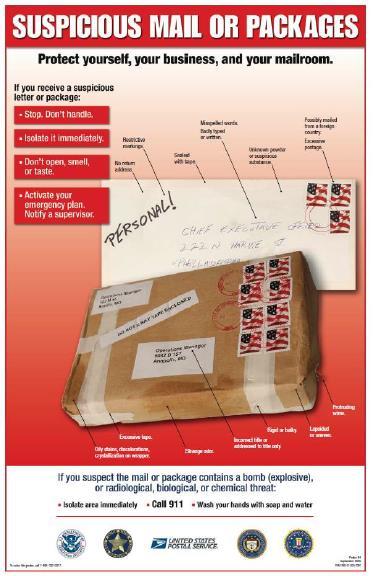
BSC Emergency Operations Plan 76
Mail or Package Indicators
Suspicious
SUSPICIOUS PERSON/ITEM
Call 911 from any campus phone or available cell phone.
Move away from any suspicious item prior to calling law enforcement.
Suspicious Person:
• If the suspicious person is still in the area, get a physical description and provide it to police: o Race o Sex o Height o Weight o Hair color
o Identifying marks such as tattoos or scars o Top clothing (jacket and/or shirt)
o Bottom clothing (pants, shorts, shoes, etc.)
• If possible, also provide any vehicle description that may assist police with locating the suspicious person:
o Make o Model
o Color
o License plate state and number
o Identifiable decals or markings on the vehicle
• Do NOT attempt to detain the person.
• Ask any witnesses to remain until a Campus Police Officer arrives.
Suspicious Item:
• Do NOT touch any package or item that appears out of place, abandoned, or otherwise suspicious.
• Move away from the item and notify law enforcement.
TORNADO
Tornados can occur just about anywhere in North Dakota. Students, staff, and faculty are encouraged to personally monitor weather conditions, NWS reports campus emergency notifications, and to sign up for weather alerts from commercial media outlets.
Tornado Watch:
BSC Emergency Operations Plan 77
The National Weather Service issues a tornado watch when weather conditions are favorable for possible formation of tornadoes.
Actions to take:
• Campus Police or Facilities will check to be sure that shelter areas are accessible should the tornado watch evolve into a tornado warning.
• Students, staff, and faculty should remain alert for approaching storms and monitor radio and television for current weather information.
• Anyone located in a temporary or modular building on campus should consider moving into a permanent structure until the threat has passed.
Tornado Warning:
The National Weather Service issues a tornado warning when a tornado has been sighted in the area or is indicated by weather radar. Take shelter immediately.
Actions to take:
• Follow directions issued by the College through its emergency notification systems
• Do not leave a permanent structure. People in modular, prefabricated, or temporary structures should immediately get to the closest permanent structure.
• Move away from windows, doors, exterior walls, hallways, and open areas.
• Take cover in a Designated Shelter Area if available.
• Evacuate upper levels and lobby areas.
• Stay away from lobbies, walkways, atriums and other large glassed-in areas, and large open areas with a long roof span such as auditoriums and gymnasiums.
• If a Designated Shelter Area is not available, move to an interior room or hallway on the lowest level of the building. Avoid long corridors that span the structure. If possible, get under a sturdy piece of furniture.
• Aid people with functional impairments or disabilities.
• Close fire doors in hallways.
• Remain in place for at least 15 minutes until the threat has passed.
If you are outside of the building and a tornado is approaching:
• Get out of your vehicle. Do NOT stay in your vehicle, and NEVER try to outrun a tornado.
• Move into a permanent building if there is time to do so safely.
• If you can’t make it to a building, lie flat in a nearby ditch or depression until the tornado has passed.
After a Tornado:
• If the building has suffered structural damage, evacuate immediately. If you cannot evacuate or are trapped, call 911.
• Follow directions of College officials and emergency responders.
BSC Emergency Operations Plan 78
• Stay clear of damaged areas.
• Beware of fallen debris, exposed electrical lines, downed power lines, and gas leaks.
• Stay with your group and account for everyone.
• Administer first aid to the injured.
Designated Shelter Areas:
• Campus users will be directed via loudspeaker system to evacuate to the lowest floor or interior corridors and stay away from glass.
BSC Emergency Operations Plan 79
APPENDIX A: AUTHORITIES AND REFERENCES
Federal
Robert T. Stafford Disaster Relief and Emergency Act and Amendments, 42 U.S.C. § 5121 et seq., (Federal Government disaster preparedness and assistance)
Title 44 Code of Federal Regulations, Federal Emergency Management Agency, Department of Homeland Security (rules and regulations on Federal disaster response and recovery)
Emergency Planning and Community Right-to-Know Act, 42 USC, Chapter 116
Emergency Management and Assistance, 44 CFR
Homeland Security Act 2002
Homeland Security Presidential Directive, HSPD-5, Management of Domestic Incidents
Homeland Security Presidential Directive, HSPD-3, Homeland Security Advisory System
National Incident Management System
National Response Framework
Nuclear/Radiological Incident Annex of the National Response Plan
Hazardous Waste Operations & Emergency Response, 29 CFR 1910.120
Comprehensive Environmental Response Compensation and Liability Act (CERCLA), 42 U.S.C § 9601 (hazardous substances releases and liability)
Clean Water Act, 33 U.S.C § 1311 (effluent limitations). Public Health Security and Bioterrorism
Preparedness and Response Act, 42 Code of Federal Regulations Part 73
Resource Conservation Recovery Act (RCRA), 42 U.S.C § 6901 (requires proper management of hazardous waste)
Public Health Security and Bioterrorism Preparedness and Response Act, 42 U.S.C § 201.
Agricultural Bioterrorism Protection Act of 2002, 7 U.S.C § 8401, (addresses possession, use and transfer of biological agents and toxins)
Hazardous Waste Operations & Emergency Response, 29 CFR 1910.120
Clery Act-Federal Timely Warning Reporting Obligations
State
North Dakota Disaster Act of 1985 (Chapter 37-17.1 Emergency Services) https://www.legis.nd.gov/cencode/37-17.1
North Dakota Department of Emergency Service Disaster Procedure Guide https://www.nd.gov/des/disaster-procedure-guide
Local
Bismarck Municipal Code
http://www.bismarcknd.gov/Code-of-Ordinances
Mandan Municipal Code https://www.cityofmandan.com/municipalcode
BSC Emergency Operations Plan 80
City of Bismarck Emergency Operations Plan http://www.bismarcknd.gov/EOP
College
North Dakota University System
ND State Board of Higher Education (SBHE) Policy 906 Emergency Preparedness and Management; Continuity of Operations; Security http://www.ndus.edu/SBHE-906
ND SBHE Policy 305.1 Institution President Authority and Responsibilities http://www.ndus.edu/SBHE-305.1
Other
The Emergency Actions Guide, Bismarck State College
SRP Guidance for Community Colleges, Trade and Technical Schools, i love you guys foundation
Special acknowledgement goes to Pikes Peak Community College and its Emergency team. This EOP is patterned after the Plan developed by Pikes Peak Community College.
BSC Emergency Operations Plan 81
APPENDIX B: ACRONYMS AND GLOSSARY
AAR After Action Review or After-Action Report
CERT Campus Emergency Response team
CMT BSC Crisis Management Team
COOP Continuity of Operations Plan
DHS Department of Homeland Security
ENS Emergency Notification System
EOC Emergency Operations Center
EOP Emergency Operations Plan
ERG Emergency Response Guide
IC Incident Command or Incident Commander
ICP Incident Command Post
ICS Incident Command System
IMT Incident Management Team
MAA Mutual Aid Agreement
MOA Memorandum of Agreement
MOU Memorandum of Understanding
NIMS National Incident Management System
OEM Office of Emergency Management
PIO Public Information Officer
SOC Student of Concern
After Action Review: A review of actions, procedures, and policies that is conducted after an incident or exercise to identify strengths, weaknesses, and areas of improvement.
Campus Emergency Response Team: College staff and faculty who are trained to respond to minor emergencies on campus and assist Campus Police with evacuations.
Campus State of Emergency: A declaration which usually suspends a few normal functions of the college, alerts staff, faculty and students to change their normal behaviors, or implements parts of the emergency operations plan.
Assurance: The system used by BSC to notify staff, faculty, and students of emergency situations on campus or affecting a campus. (Also see Mass Notification System)
Bismarck State College Emergency Operations Plan 80
Continuity of Operations Plan: A plan to restore complete operations and/or relocate operations following a major disruption such as a natural disaster or fire that affects the College’s physical assets and facilities.
BSC Emergency Operations Plan 82
Crisis Management Team: A group of College senior staff members that supports emergency operations and advises the Incident Commander. The CMT may be activated for in-house special event management.
Department of Homeland Security: Federal department tasked with homeland security missions including preventing terrorism and enhancing security; securing and managing borders; enforcing and administering immigration laws; safeguarding and securing cyberspace; and ensuring resilience to disasters.
Designated Shelter Area: An area in a building that has been designated as a preferred place to take cover shelter in the event of a tornado or other emergency event.
Emergency: Any incident, whether natural or human-caused, that requires responsive action to protect life or property.
Emergency Notification System: A communications system designed to provide emergency notification via text messaging, e-mail, telephone, and/or other electronic methods.
Emergency Operations Center: The designated facility where the campus Emergency Management Operations Group will convene during an emergency or disaster. The ECC may be located on campus or at an off-site location as the situation dictates. A facility designated for managing a disaster or emergency. It is where the local first responders Incident Management Team makes decisions to allocate and coordinate resources, provides for incident communications coordination, and directs the overall disaster emergency response. This center may be separate from the Incident Command Post.
Emergency Responder: Any member of campus or local emergency services, to include law enforcement, fire, and emergency medical services.
Emergency Response Guide: Quick reference charts for emergency situations posted in each classroom and office area at all BSC locations.
Evacuation: An emergency protocol in which all of a building’s occupants are required to exit the building.
Finance Section: In the Incident Command System, this section manages all financial aspects of the incident to include purchasing and contract support.
Hazardous Material: Any substance or material that, when involved in an accident and released in sufficient quantities, poses a risk to people’s health, safety, and/or property. These substances and materials include explosives, radioactive materials, flammable liquids or solids, combustible liquids or solids, poisons, oxidizers, toxins, and corrosive materials.
BSC Emergency Operations Plan 83
Incident Command Post: The location(s) from where the local first responders Incident Commander and his/her staff manage an emergency incident, as determined by local first responders.
Incident Commander: Person who is responsible for the overall management of the incident.
Incident Management Team: A multi-agency/multi-jurisdictional team that is formed and managed at the local, state, or federal level, and is used for extended incidents,
Liaison Officer: In the Incident Command System, the person assigned to coordinate incident activities with all participating emergency response agencies.
Lock down: An emergency protocol in which access to a building is restricted by locking all exterior building doors.
Logistics Section: In the Incident Command System, this section provides facilities, materials and services for the incident.
Memorandum of Understanding: An agreement between jurisdictions to aid and resources during times of emergency.
National Incident Management System: A flexible framework of doctrine, concepts, principles, terminology, and organizational processes that apply to all hazards and jurisdictions.
Operations Section: In the Incident Command System, this section manages tactical operations at the incident.
Planning Section: In the Incident Command System, this section manages all information relevant to the incident and provides the operational support required for long-term incidents.
Policy Group: Formed around the President's Executive Cabinet, the Policy Group serves as an advisory board for the President and provides strategic guidance during incidents.
Public Information Officer: Individual develops and releases information about the incident to the media, incident personnel, and other appropriate agencies and organizations.
Reverse Evacuation: An emergency protocol in which persons outside of the building are directed to return to the shelter of the building. Such a protocol might be used in the event of sudden and threatening weather or other threat outside the building.
Safety Officer: In the Incident Command System (ICS), the Safety Officer oversees safety for the incident.
BSC Emergency Operations Plan 84
Service Animal: Any guide dog, signal dog, or other animal trained to assist an individual with a disability.
Shelter-in-Place: An emergency protocol in which all building occupants are directed to remain in their offices, classrooms, or work areas for safety reasons.
Student of Concern Team: is a multi-disciplinary group whose purpose is to support a safe and productive learning and working environment for the College via an established student behavior intervention protocol. The team tracks “red flags” over time, detecting patterns, trends, and disturbances in individual or group student behavior. The team receives reports of disruptive, problematic, or concerning behavior or misconduct by students (from co-workers, community members, friends, colleagues, etc.), investigates, performs a threat assessment, and determines the best mechanisms for student support and intervention, warning/notification, and response. The team then deploys its resources and resources of the community and coordinates follow-up
Unified Coordination System: A formal system used to coordinate resources and support between agencies or jurisdictions in regional situations.
BSC Emergency Operations Plan 85
APPENDIX C: BSC BUILDING ADDRESSES
Armory 1601 Edwards Ave. Bismarck, ND 58501
Career Academy 1221 College Dr. Bismarck, ND 58501
Foundation 1255 Schafer St. Bismarck, ND 58501
Health Sciences 1133 College Dr. Bismarck, ND 58501
Jack Science Center 1420 Schafer St. Bismarck, ND 58501
LEA (Library, English and Art) Hall 1400 Schafer St. Bismarck, ND 58501
Lineworker Program 3201 Nygren Dr. NW Mandan, ND 58554
Mandan Campus-Mechanical Maintenance 1831 Twin City Dr. SE Mandan, ND 58554
Meadowlark Building
1700 Schafer St. Bismarck, ND 58501
National Energy Center of Excellence 1200 Schafer St. Bismarck, ND 58501
Gate City Bank Hall 1226 Edwards Avenue Bismarck, ND 58501
Lidstrom Hall 1330 Edwards Ave. Bismarck, ND 58501
Mystic Hall 1309 Schafer Street Bismarck, ND 58501
Ritchie Hall 1248 Edwards Ave. Bismarck, ND 58501
Swensen Hall
BSC Emergency Operations Plan 86
1411 Schafer St. Bismarck, ND 58501
Werner Hall
1600 Edwards Ave. Bismarck, ND 58501
Robert A. Kuntz Physical Plant
1613 Edwards Ave. Bismarck, ND 58501
Schafer Hall 1500 Edwards Ave. Bismarck, ND 58501
Student Union 1425 Schafer St. Bismarck, ND 58501
Technical Center
1200 College Dr. Bismarck, ND 58501
BSC Emergency Operations Plan 87
